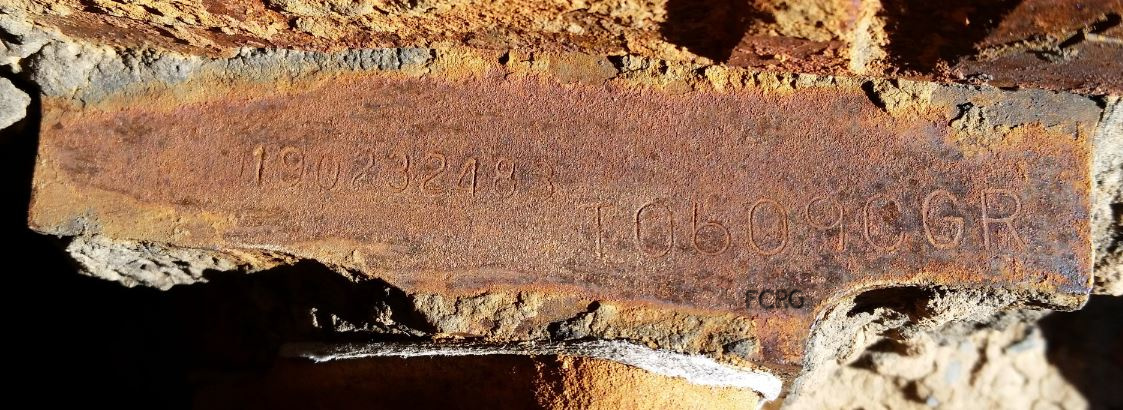©2019, Full-Size Chevrolet Research Group
Edited by Warren Leunig
Version: Saturday, 3-Aug-2019 09:06:20 EDT
- Introduction
- Ordering
- Building the Car
- Police Cars as an RPO or COPO
- Government Vehicles
- Taxicabs
- COPO 9665 – Turbo Hydramatic 350 for 1968
- COPO 9564 – 400ci Small Block for 1969
Introduction
What are these abbreviations? The term COPO (Central Office Production Order) is more associated with 427 Camaros and Chevelles but what do they have to do with the full-size cars? And what is a Fleet & Special Order (F&SO)?
When you wanted to order something that was not available as a Regular Production Option (RPO), typically for police cars, trucks, and commercial vehicles, you had to place a special order. Via the COPO process, Chevrolet would evaluate whether it was worthwhile to engineer and build the special order. It would develop the pricing for the order. COPO’s enabled the use of different components than were available on production vehicles. Some COPO’s, once designed, were published to be available for others to order. Some COPO’s were one-off and only used by one customer. (Many COPO’s were for trucks with special wheelbases or unique equipment mounting capability or other special modifications.)
Starting in 1963, RPO’s consisted of a letter followed by two numbers, e.g. M20 transmission. COPO options consisted of 4 digits starting with a 9, e.g. 9822. Some COPO’s were so standard that they were assigned RPO style codes, referred to as Limited Production Options (LPO), e.g. B02 Taxicab Equipment. Sometime in the 70’s, all the published COPO’s converted to the RPO format and became known as Special Equipment Options (SEO). The 9C1 police package is the most famous of those SEO’s and the mid-70’s literature still called them COPO options.
F&SO orders were generally used to generate a discount for fleet orders and for special orders that didn’t require engineering, most commonly special paint and special paint instructions (stripe changes, etc). F&SO numbers were also used to track COPO orders.
Ordering
It all started in the price schedule, which listed all the options and prices available for Chevrolet vehicles. From 1965-1967, a separate section titled Special Equipment listed ‘standard’ COPO options that could be ordered by the customer. Say the local police department came in looking to order several Biscayne cop cars with 396 engine and provisions for a roof light. The salesman would look in Special Equipment section where the police package with the 396 engine option could be found. Additionally, they would find options for a factory installed roof reinforcement plate and roof wiring so a roof light could be installed after delivery. For specific questions and an even greater selection of special equipment, the salesman would call the Zone Distribution Manager, who had a more detailed list. For example, government vehicles often had some oddball COPO’s created by Chevrolet Engineering such as extra decals or factory undercoating. Chevrolet would also evaluate special requests to see if they were worthy of developing a new COPO for the customer.
Once they settled on the equipment needed, the salesman would fill out the order form. The regular production options were checked off on the front side. A space was given on the order sheet to hand write in any additional options (including COPO’s) or specific instructions for the order. It was then sent to the zone office for approval. Some COPO options required a “Request for Authorization” form to be filled out and submitted for approval. When the order was approved, the dealer was sent a order confirmation card, where they were to confirm that the order details were correct. A scheduled date of production card was also mailed to the dealer. These orders were usually time sensitive so the dealers would request updates on the timeframe for build and delivery.
1961 and 1966 Price Schedule pages
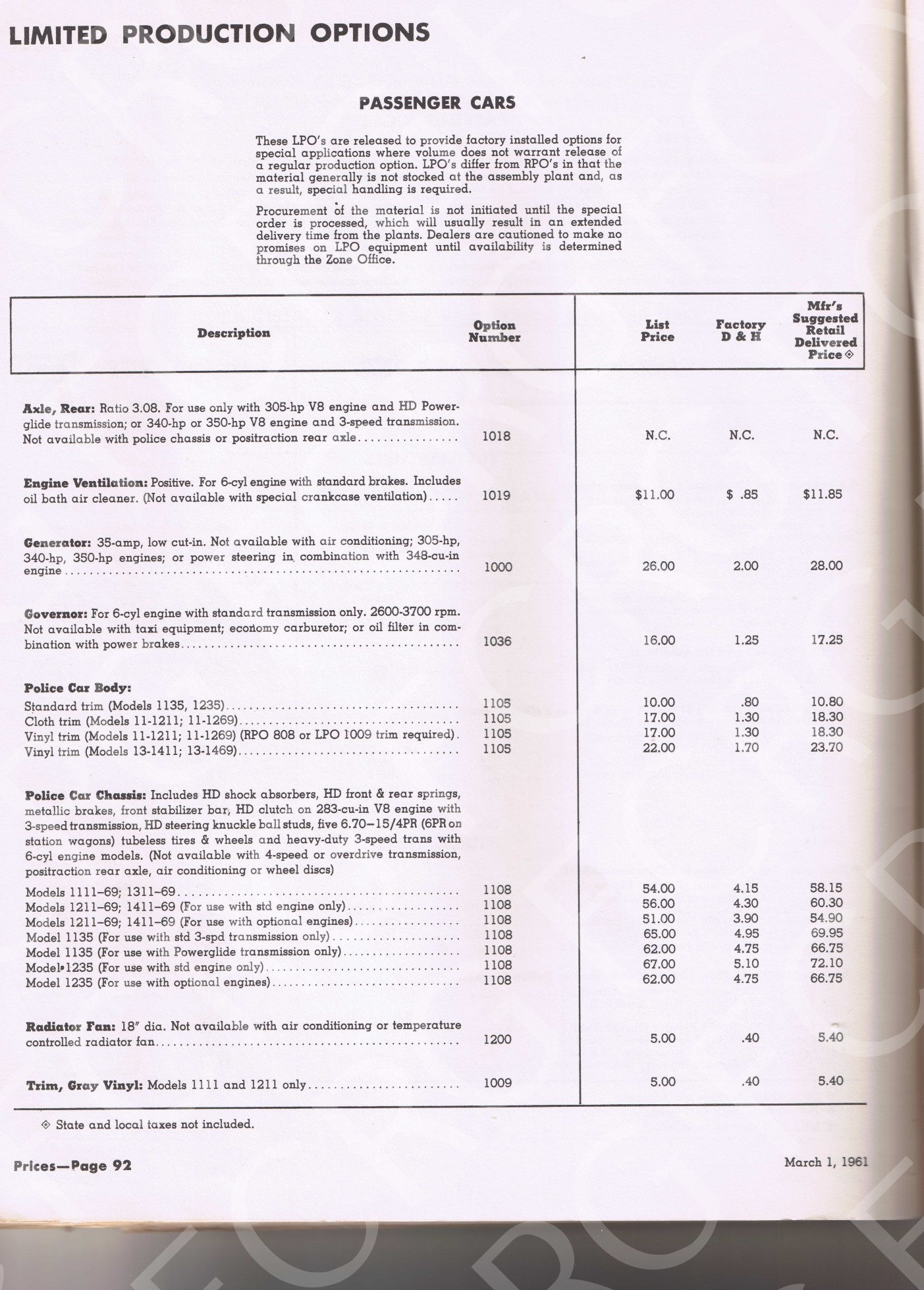

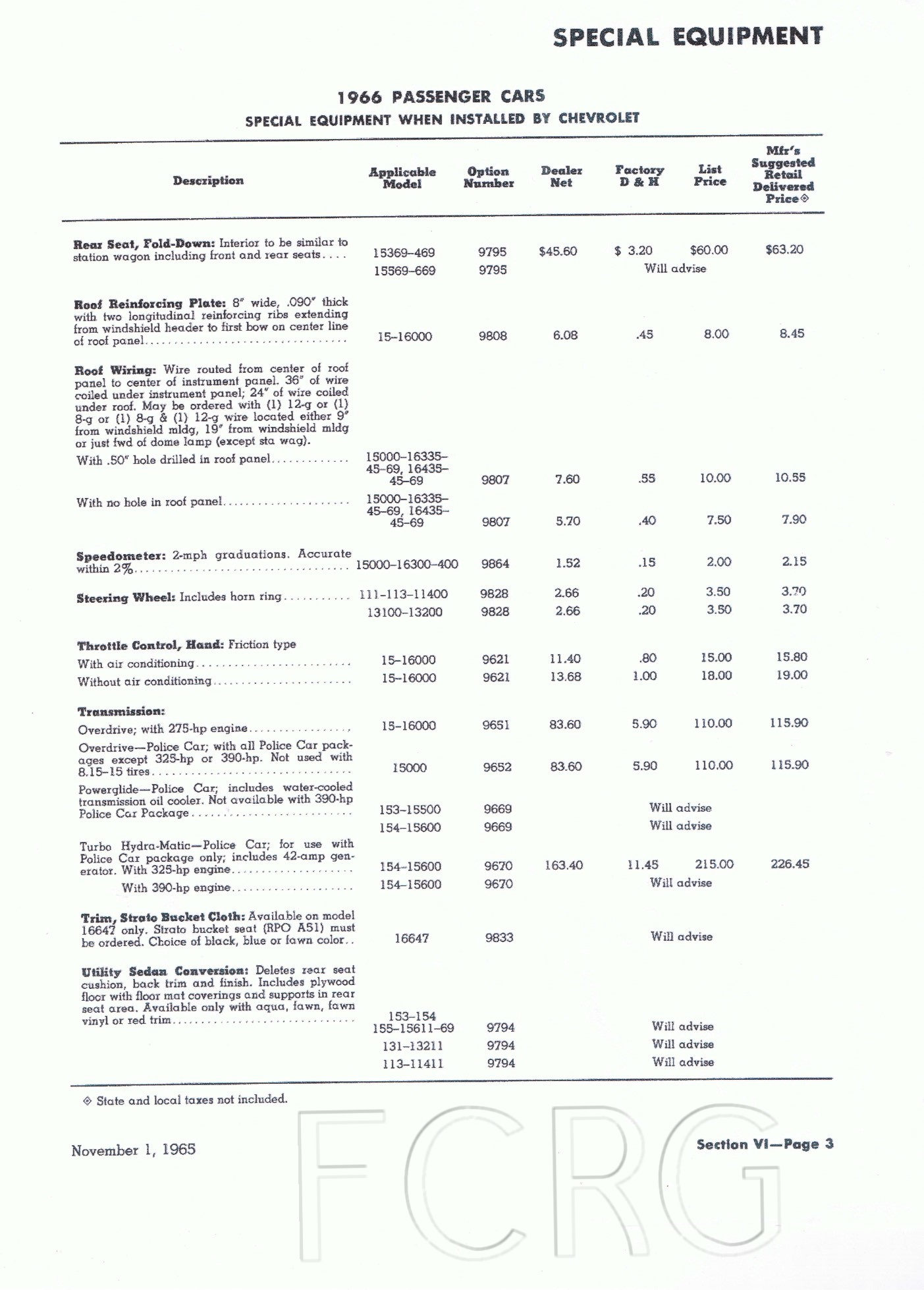
1961 Police order specifications, 1965 order form for COPO 9816 police package with 283 engine and 1965 bid write-up for the 327 police package.
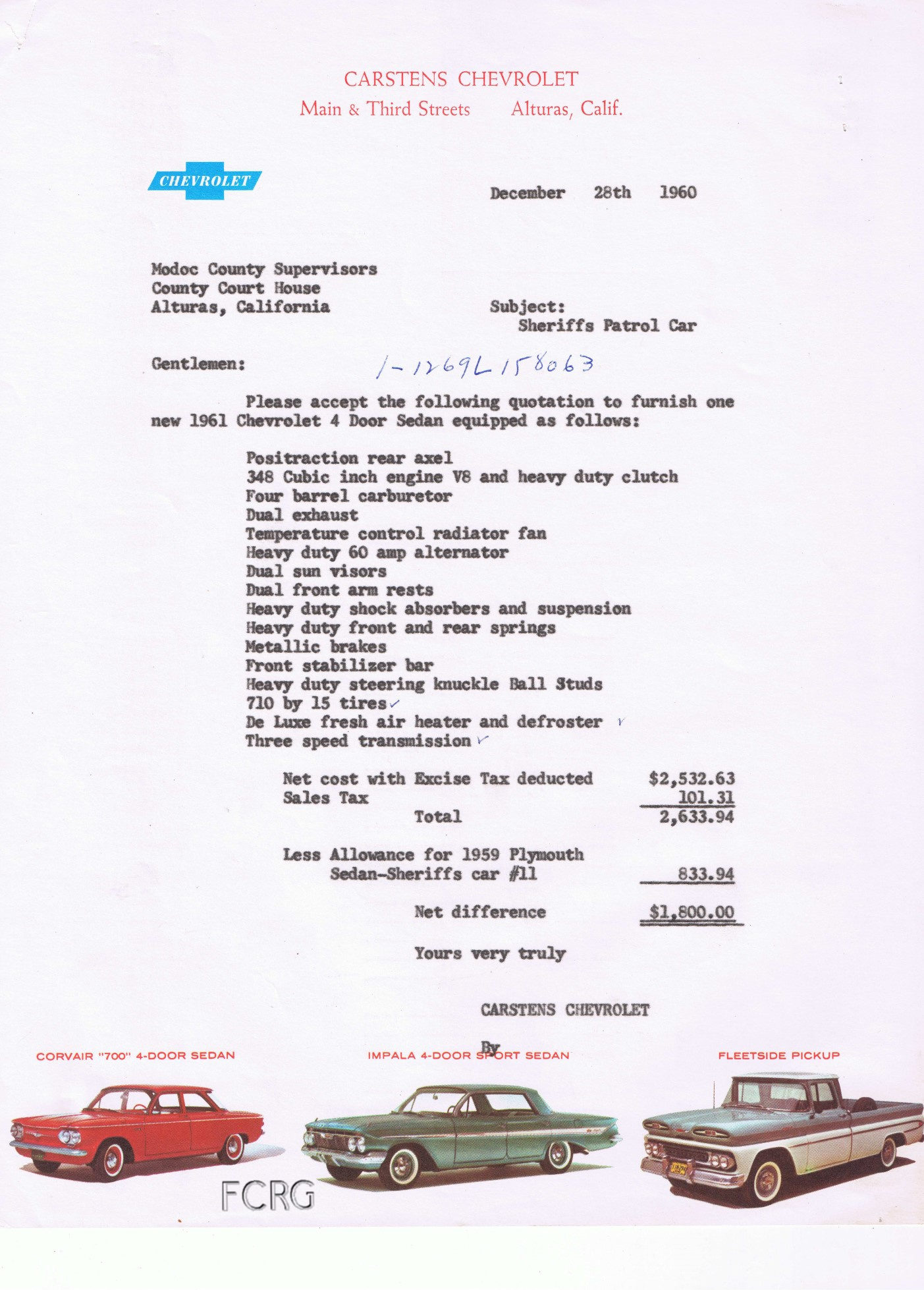


1967 Police car order- Biscayne with COPO 9819 Police Pkg (327 engine): Order form, request for COPO authorization and factory invoice. This car had a fawn cloth interior, instead of the fleet type vinyl that was ordered with most police cars. It is noted on the authorization paper. Note the F&SO number FL188A on the invoice, which would have also appeared on the cowl tag.
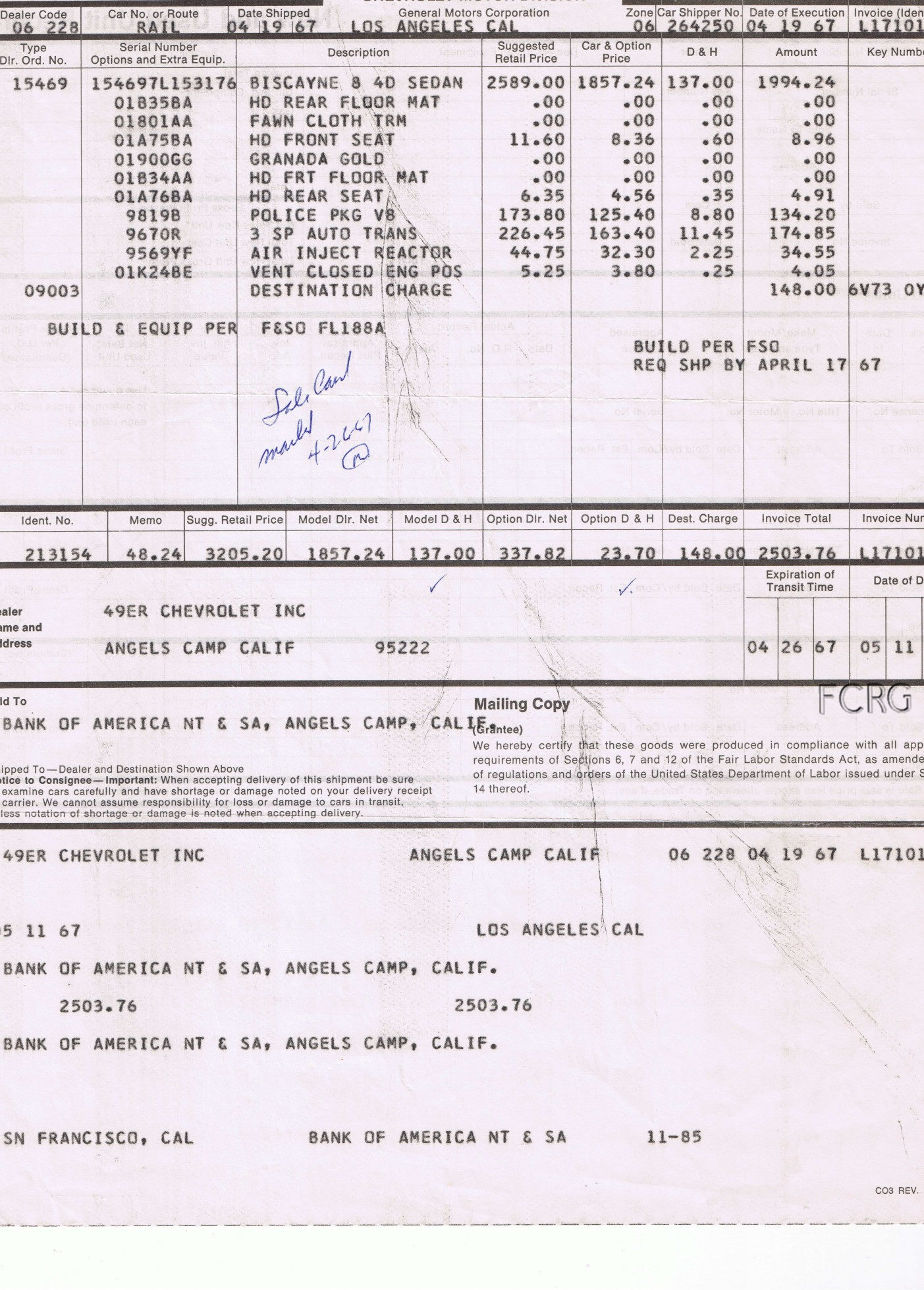

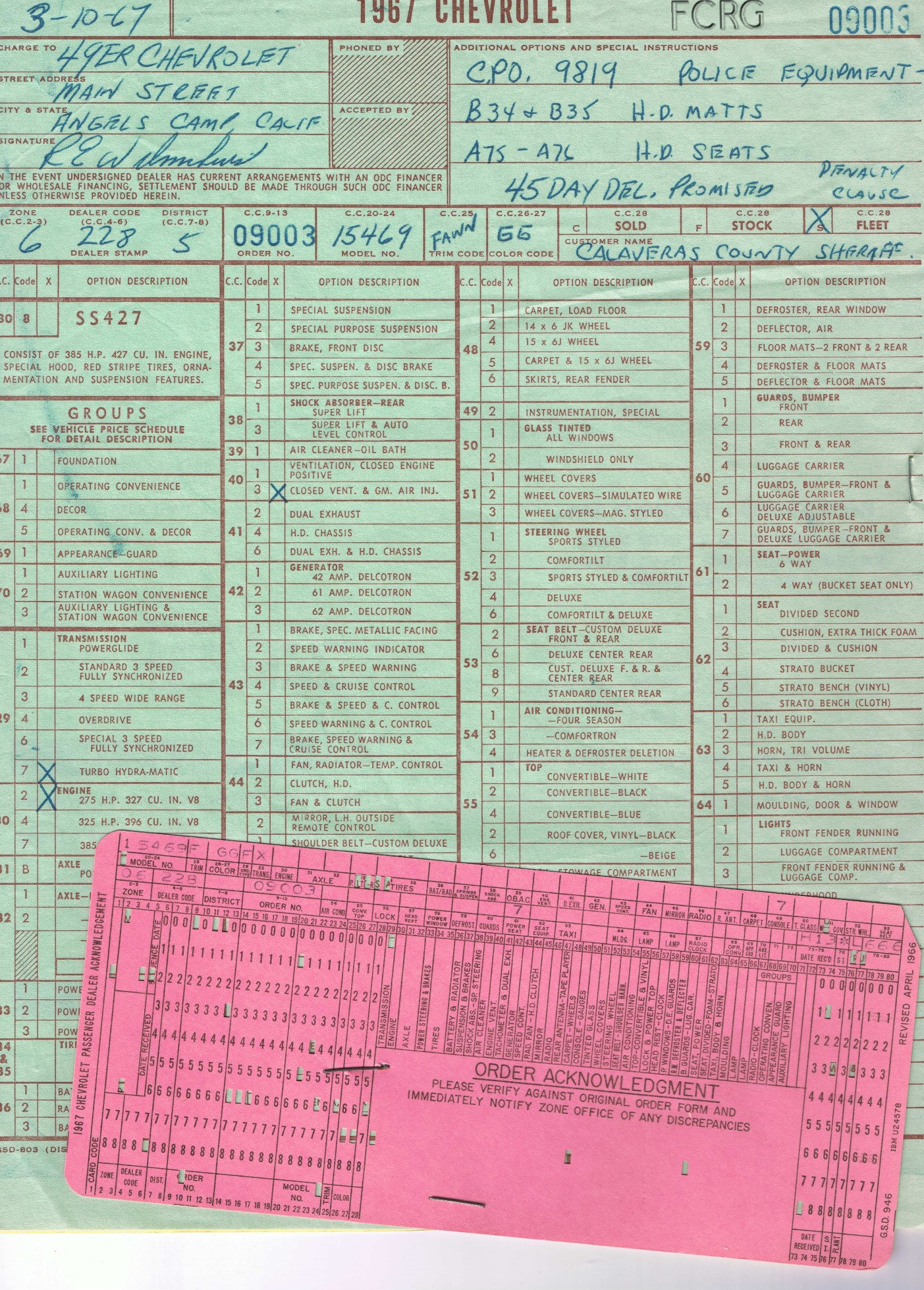
1968 Police car order: Order form plus correspondence from the zone office about substituting the 396 for the 327 due to material shortages and the requirement to add V01 heavy duty radiator to the order.
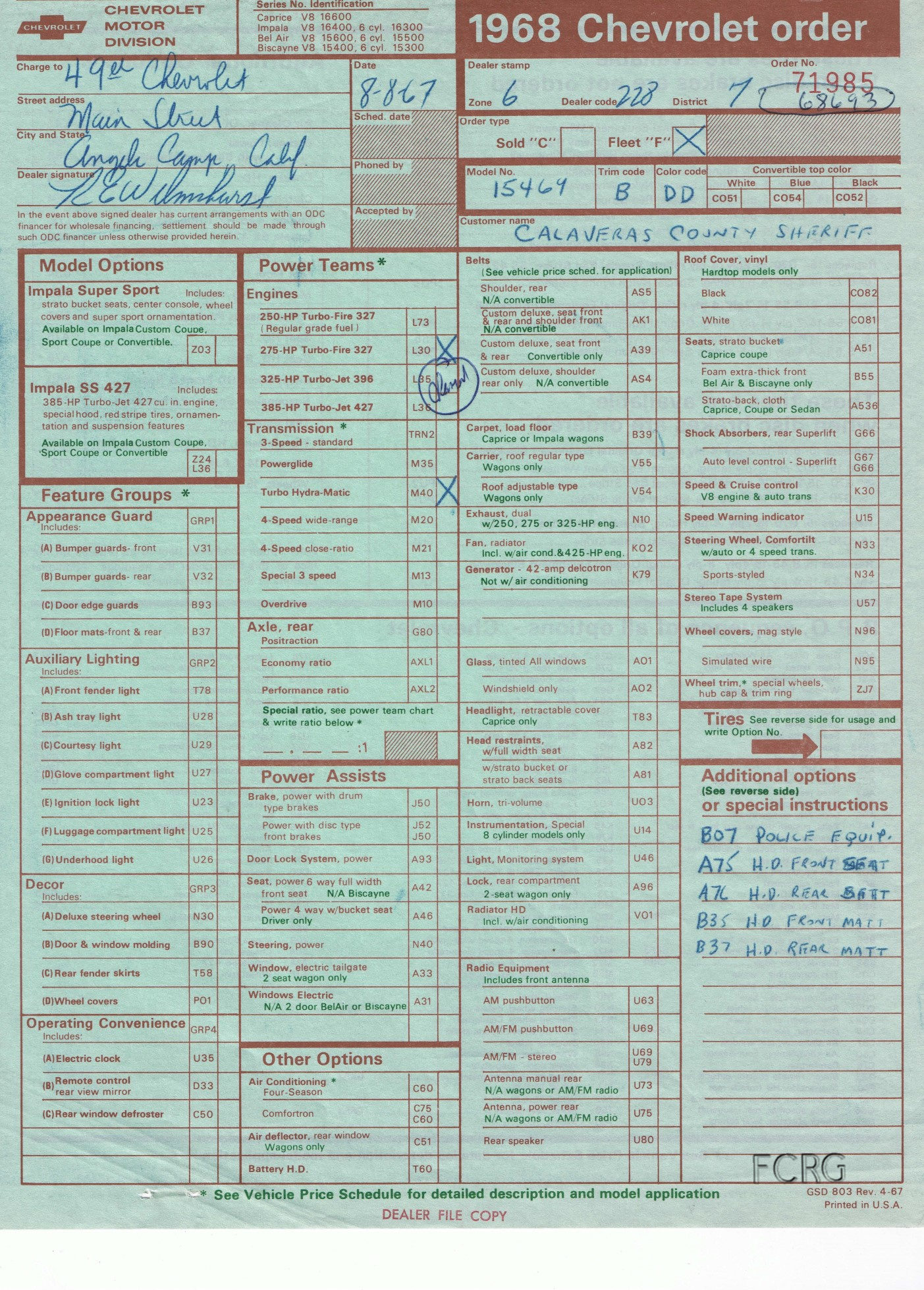

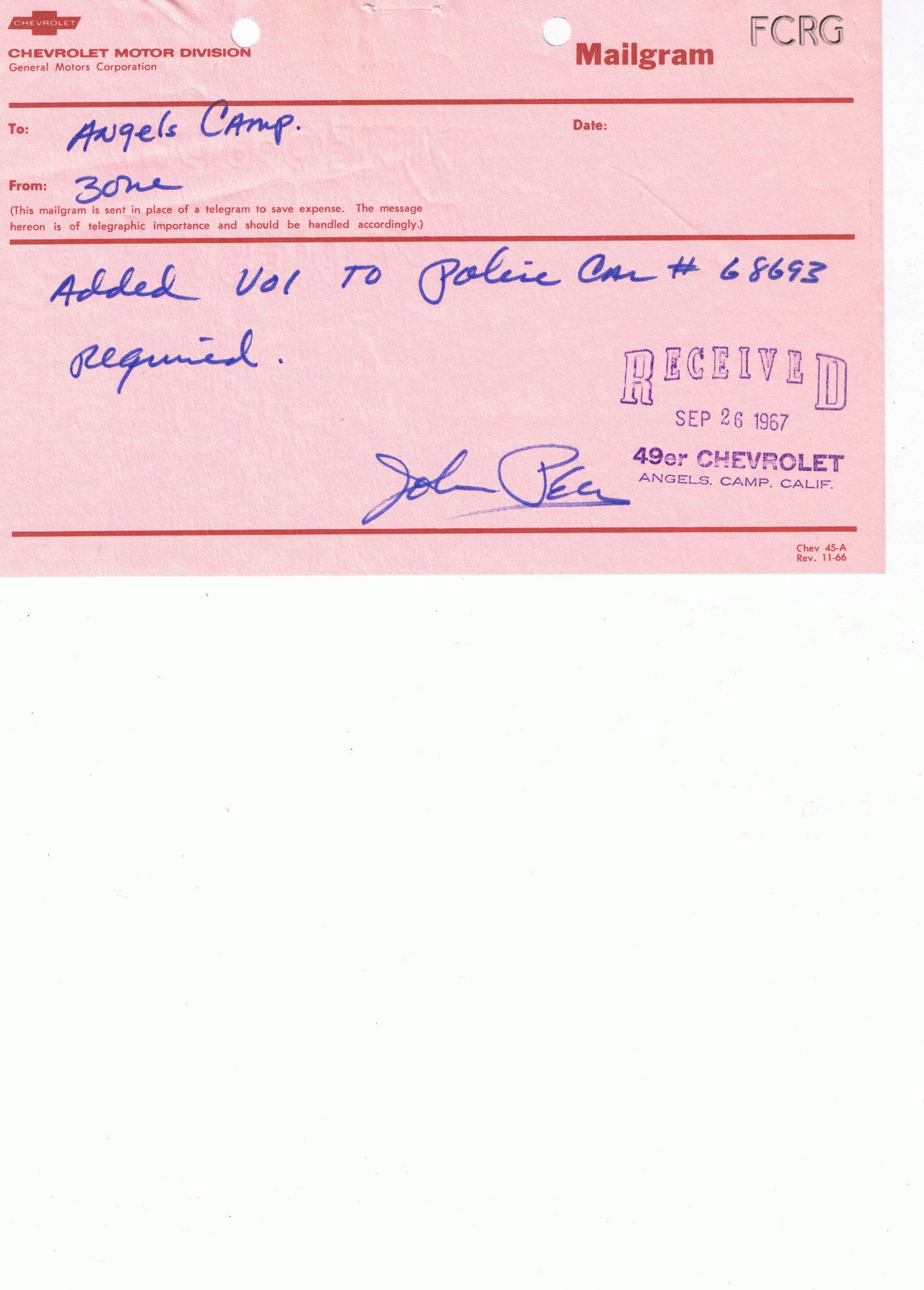
1969 Police car order: Order form, heads up letter to the zone office and cover of the folder used to keep track of the bid paperwork. Note the COPO gauges!
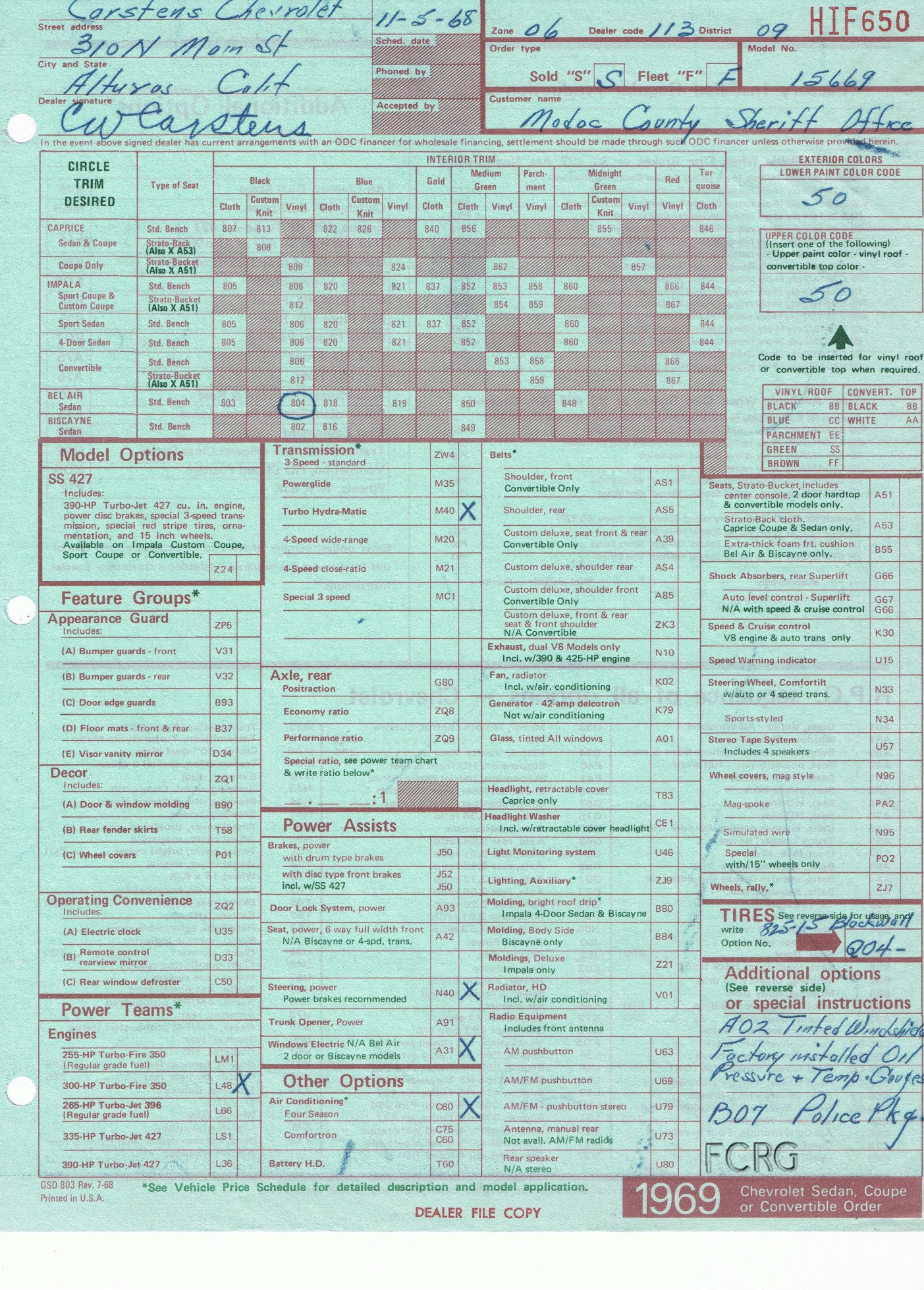
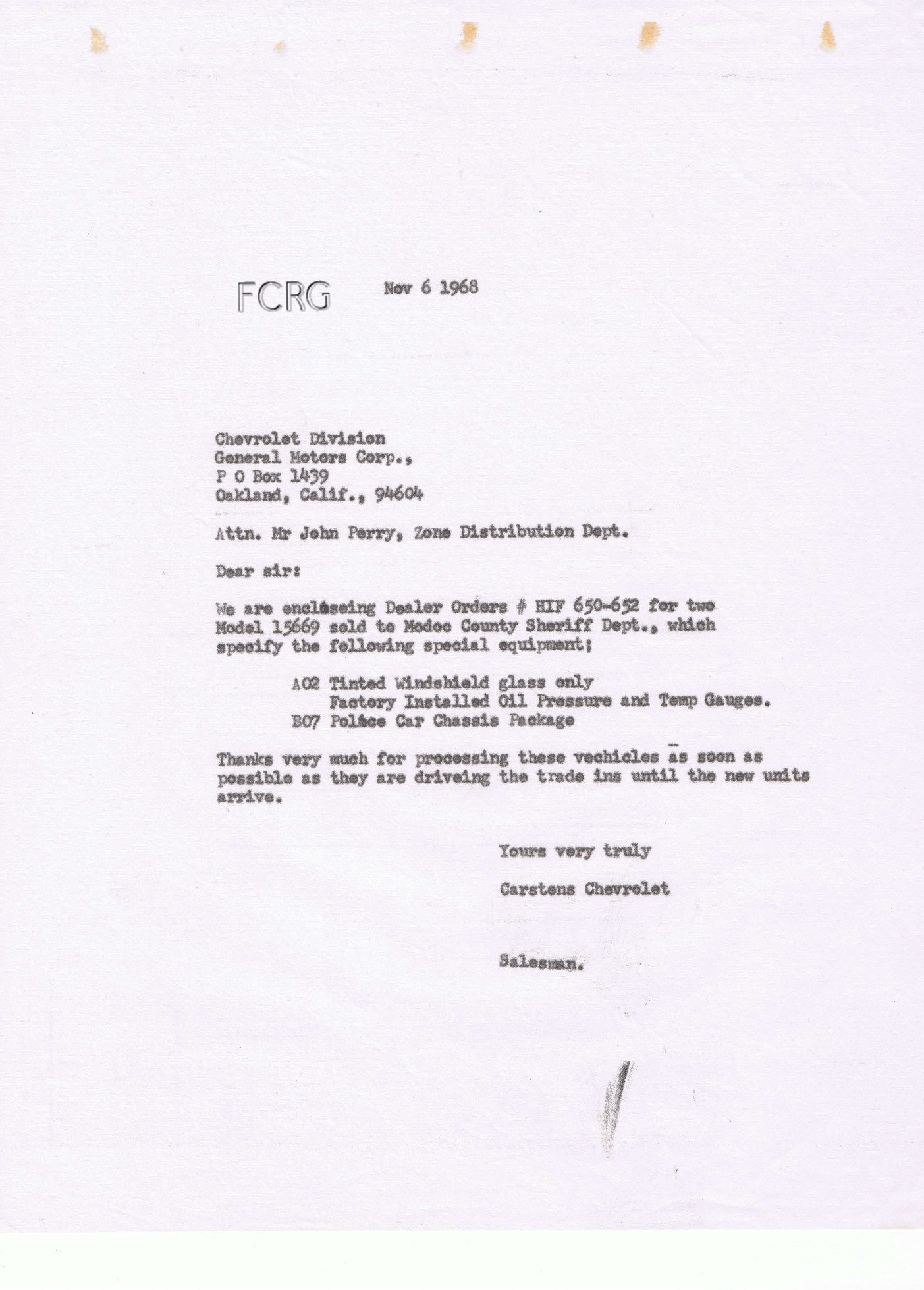
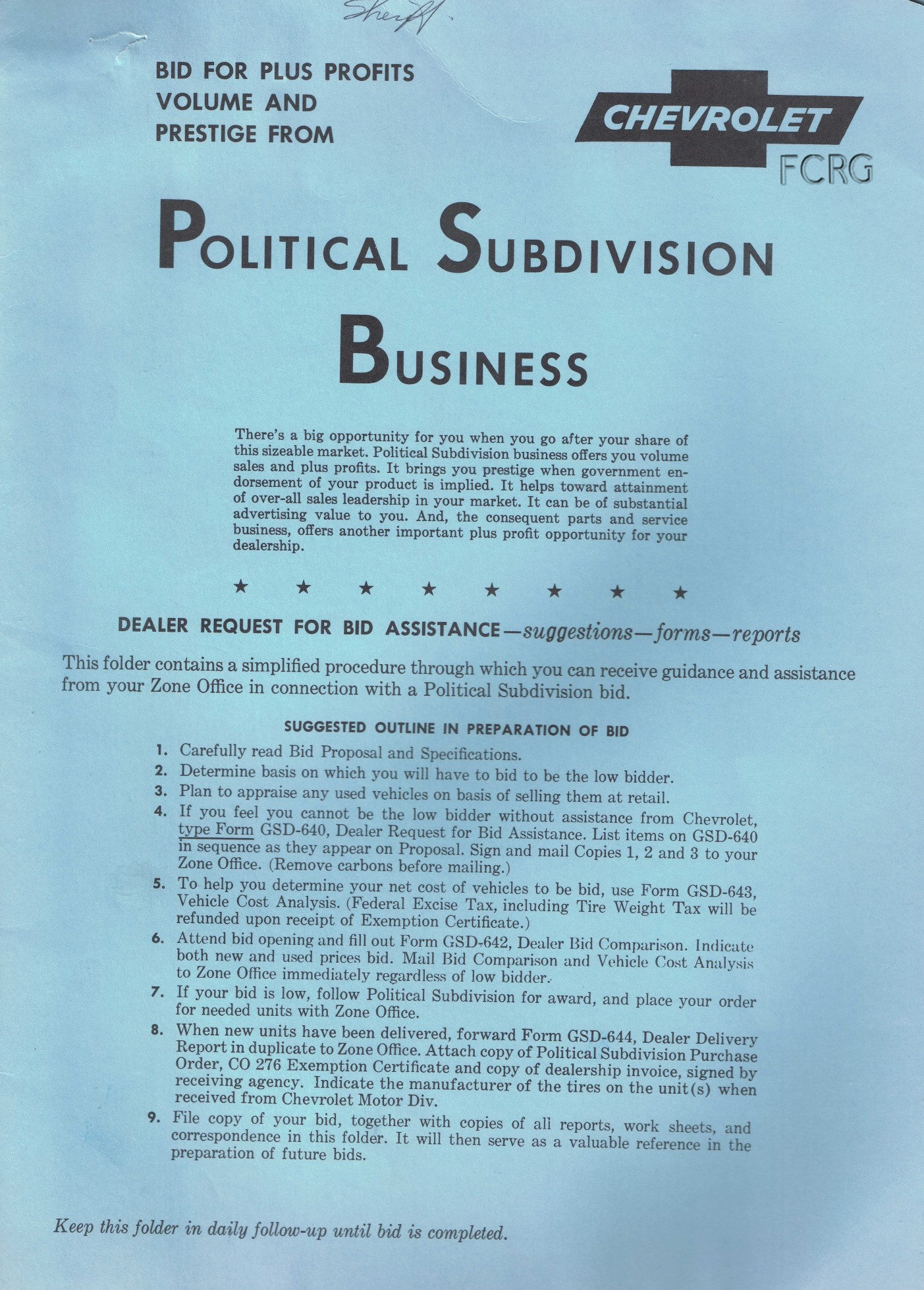
Building the Car
Once the assembly plant confirmed the required parts and materials were at the plant, the build could be scheduled. These special orders had specific instructions shown on the build sheet, including the COPO numbers. The build sheet from a special paint car would show the paint number and paint instructions. The build sheet also listed which parts were to be installed on a vehicle via a two letter broadcast code on them, both normal production parts and special COPO parts. Some of the parts that used these codes included shocks, springs, steering columns and radiators. The assembly line worker would grab the part listed on the build sheet to install on the car. There was also a plant specific F&SO number, which appeared on some plants’ cowl tags. It sometimes began with the letter of the plant like F or T then had a sequential number after it. Janesville used the word MEMO before the number. If the line worker saw this, they would refer to the build sheet or other specific instructions for the build.
Body and Chassis broadcast sheets from a 1967 Biscayne with COPO 9820 Police package with 396 engine. Bonus: BBC from a 1968 Chevelle 300 Deluxe four door sedan, ordered by the government with various COPO options. Note the instructions on all 3 documents.



1st 4 photos: 1968 Impala wagon order with special paint. Order form, factory invoice, car shipper and build sheet with paint specifications written in. Also, 1967 Caprice build sheet from special paint car (Cadillac Summit Gray) and 1968 Biscayne police car build sheet, detailing special paint and what the COPO gauges consisted of.
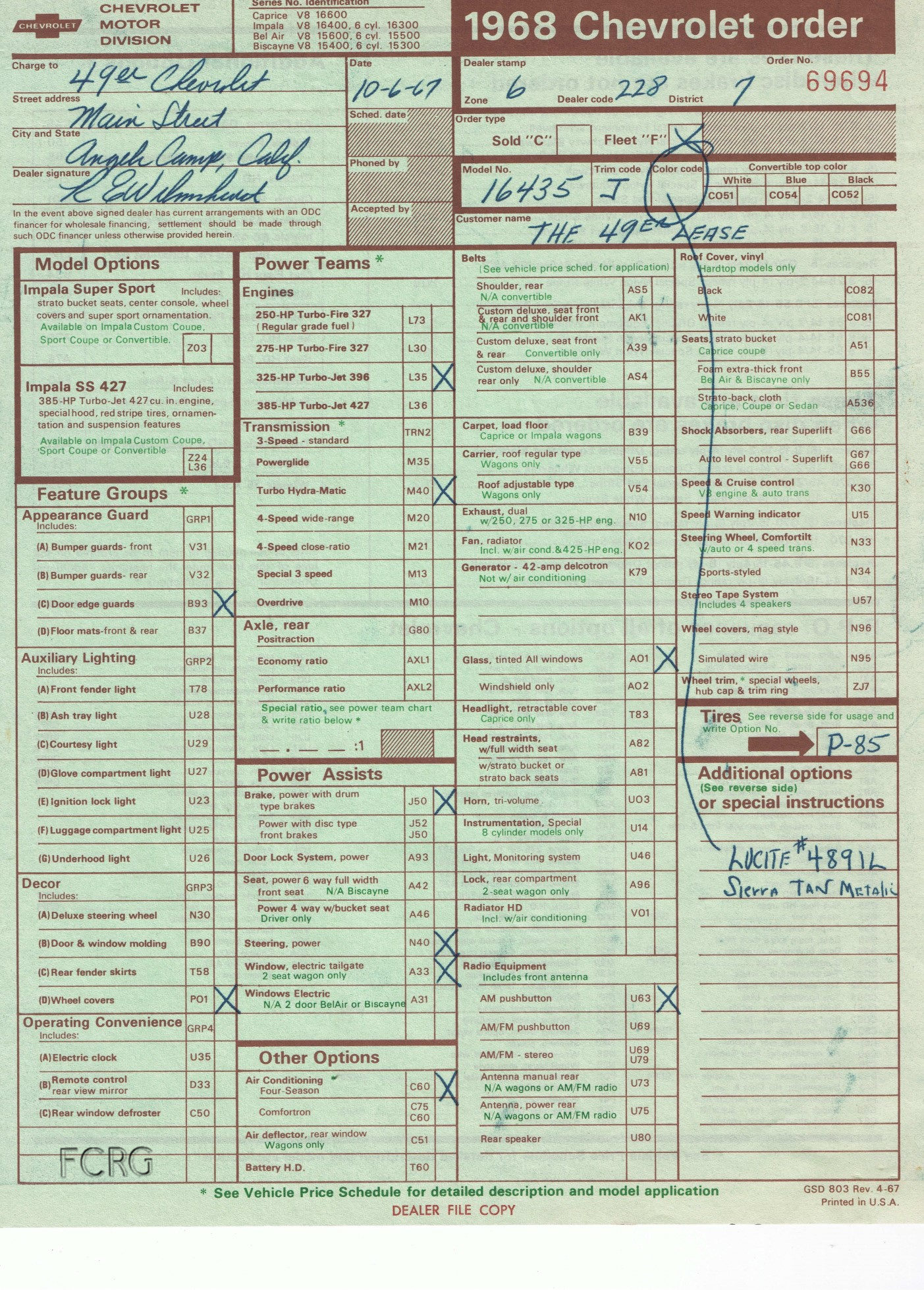

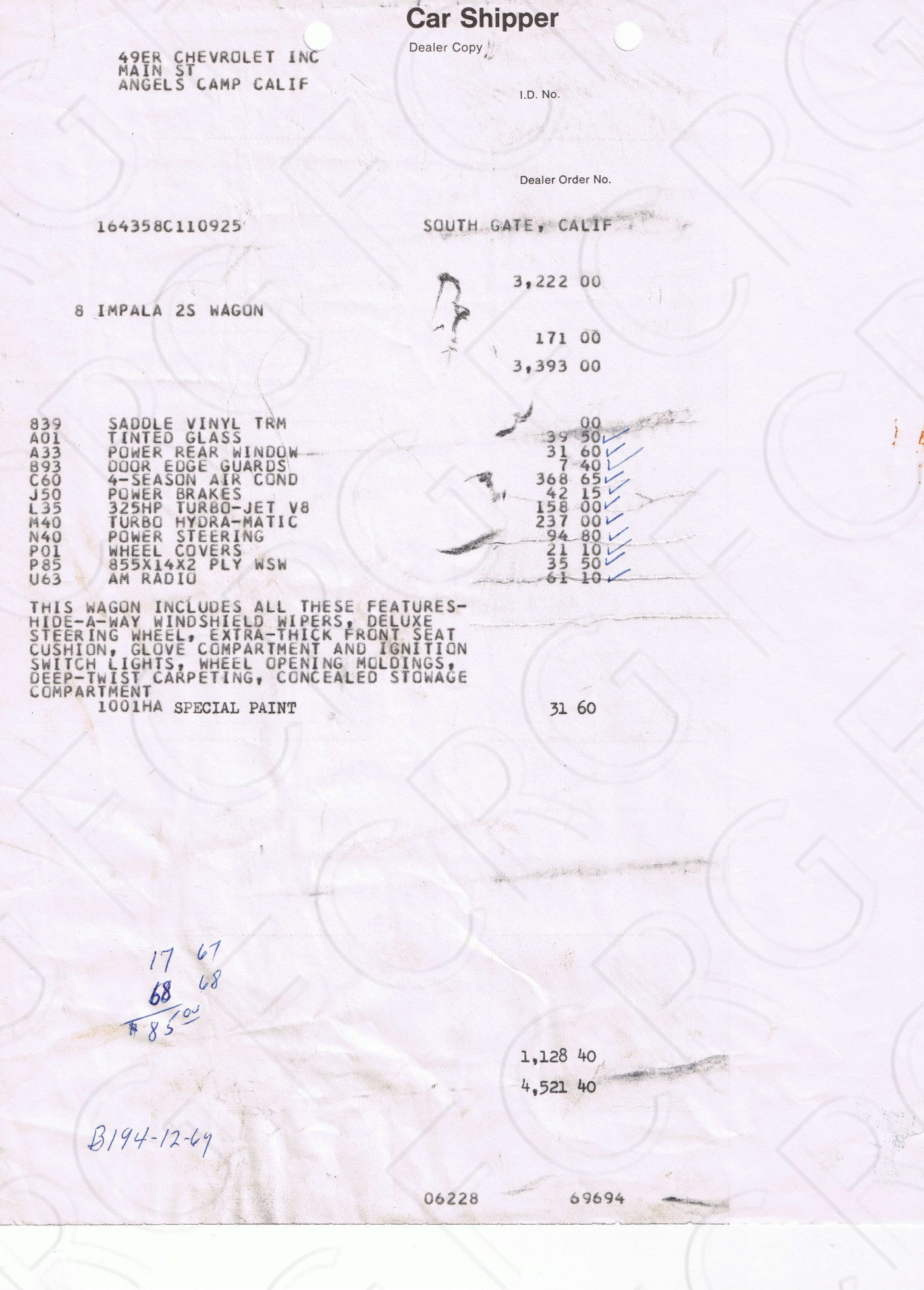
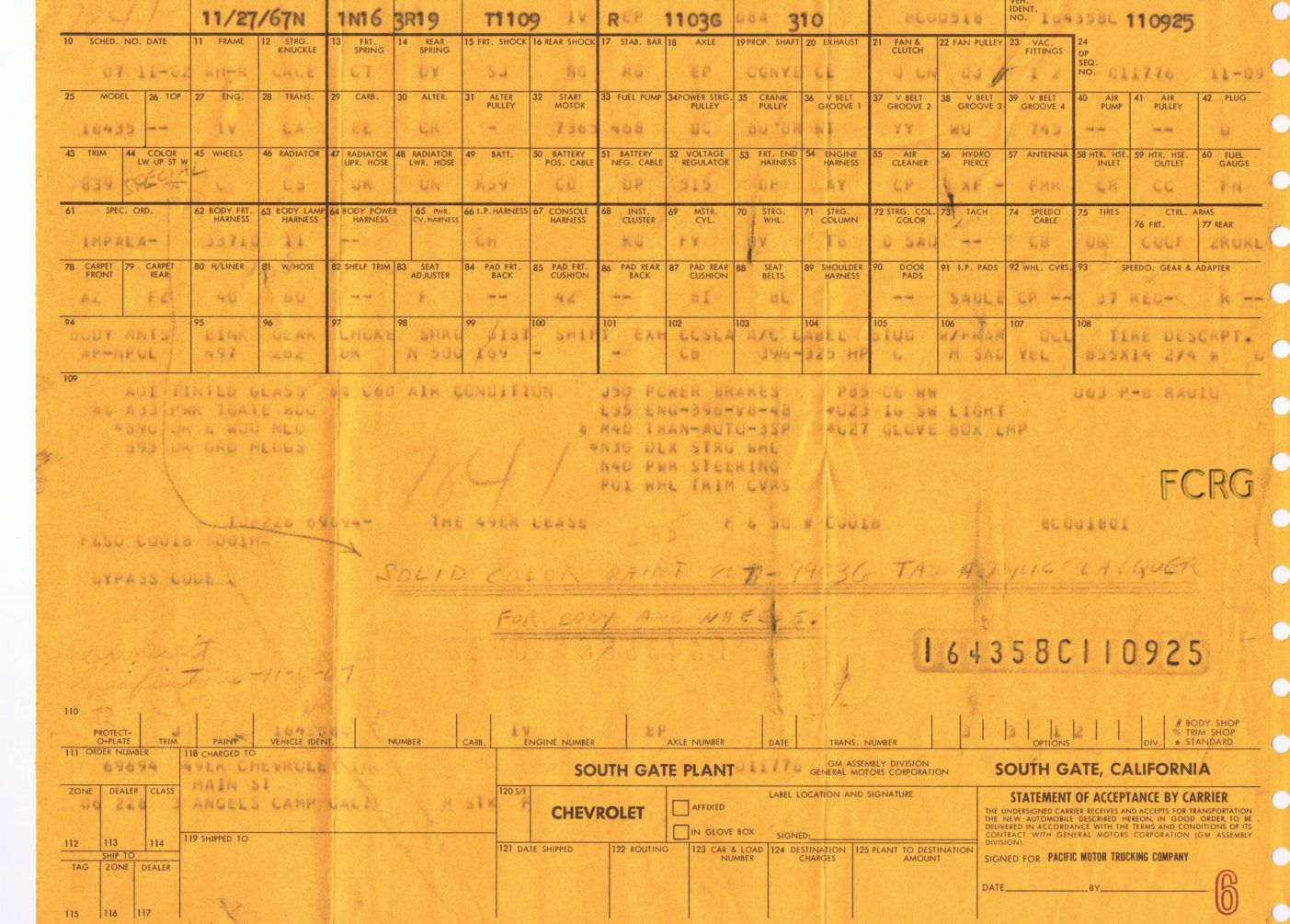
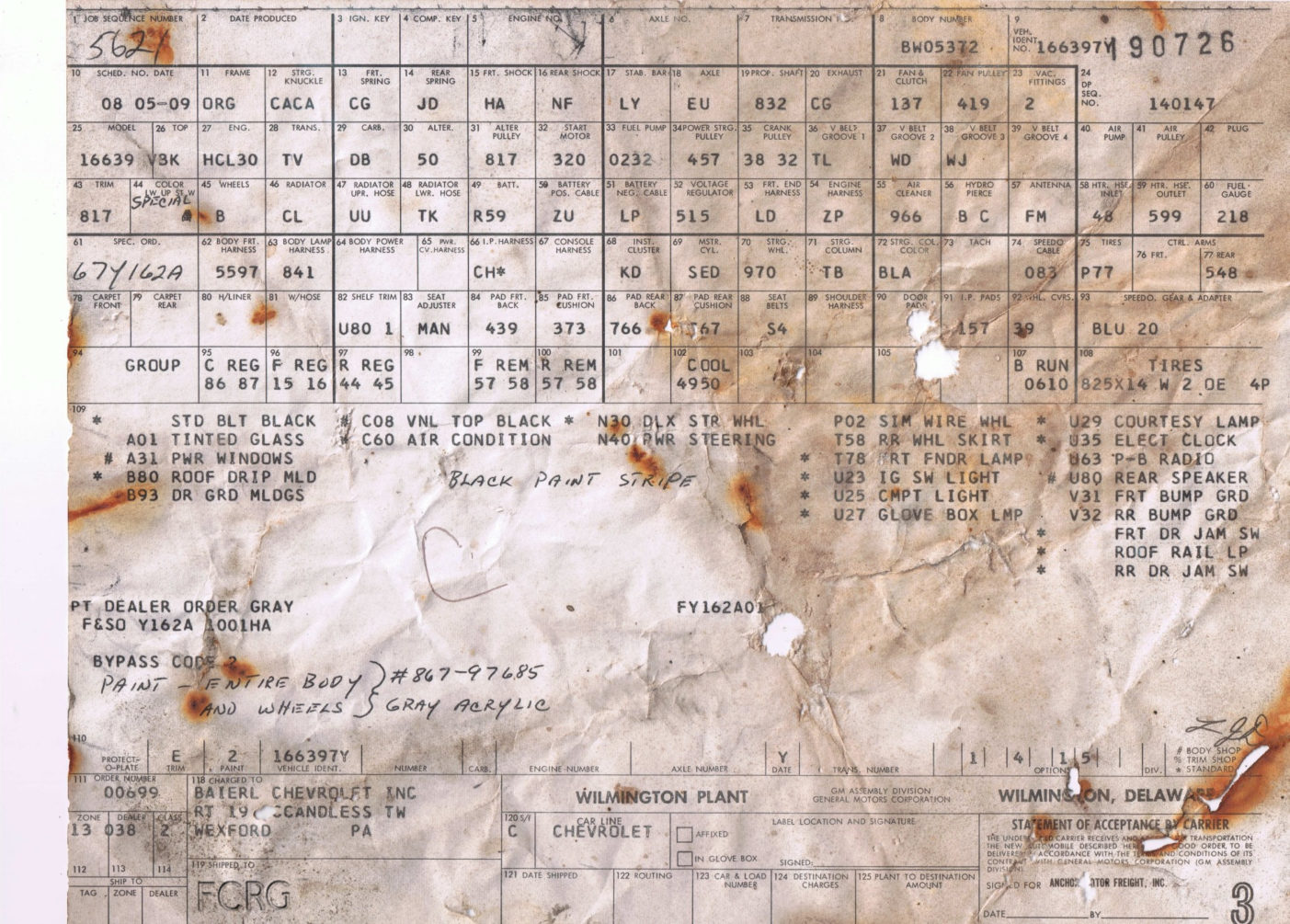

Police Cars as an RPO or COPO
Police cars could be ordered in two ways, as a special LPO or as a COPO. Up to 1967/1968, B01 Heavy-duty body equipment was used as was Z04 Police chassis equipment. Starting in 1968, B07 police car chassis package was used. Any agency could order these options on a Biscayne sedan only. On the other hand, if you needed something special or wanted to order a Belair police car, you had to go the COPO route. There were several COPO police car packages available each year with a separate option number for each engine size. For example, the base 1964 police car package with the 283ci V8 package was COPO 9816. The 1964 police car package with the 409/340ci engine was COPO 9822 – it was available on all Biscayne and Belair models including station wagons. Some restrictions for these COPO packages did apply. According to a 1964 option list, only agencies that were tax supported could purchase them. In 1967, they were only available when RPO’s B34-B35 HD floor mats, A76 HD rear seat (sedans only) and A75 HD low profile front seat were ordered. These packages normally had unique engine suffix codes and in some cases, special rear axle codes. Some additional COPO options were only available with them.
Police car invoice gallery!
First row: 1963 Biscayne ordered with regular RPO’s, 1964 Biscayne with COPO 283 police car package and 1965 Biscayne with regular RPO’s. (Note B01 H.D. Body Equipment)
Second row: 1965 Biscayne 2dr with 396 Police package and several other COPO’s, 1966 Biscayne 4dr also with the same 396 package and 1967 Belair ordered with the 327 police package, overdrive transmission and the police gauge dash.
Third row: 1967 Impala four door sedan police car ordered with all RPO’s except COPO roof reinforcement plate and wiring equipment, 1968 Biscayne 396 with all RPO’s and 1968 Biscayne 307 with a mix of RPO’s and COPO’s.
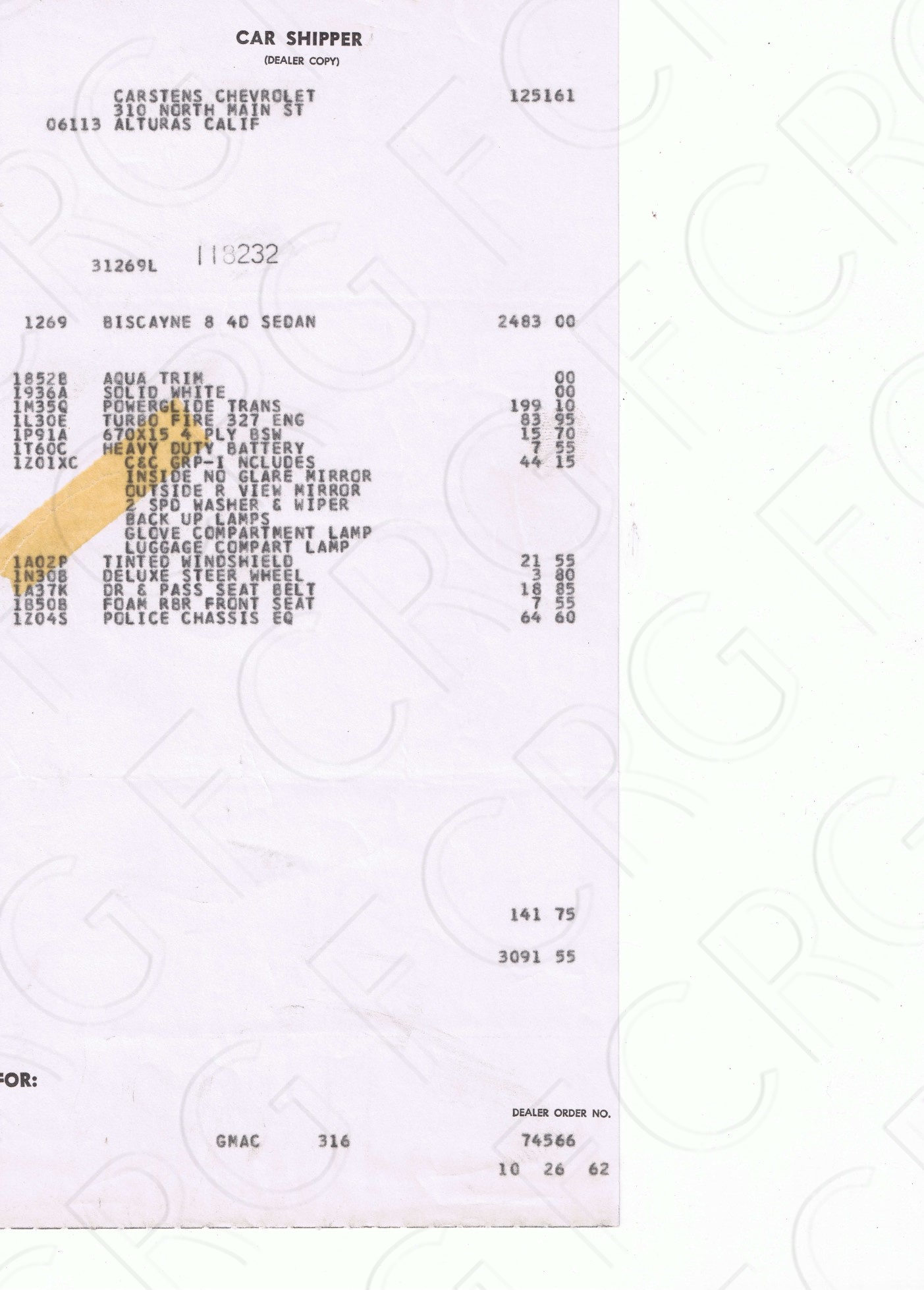

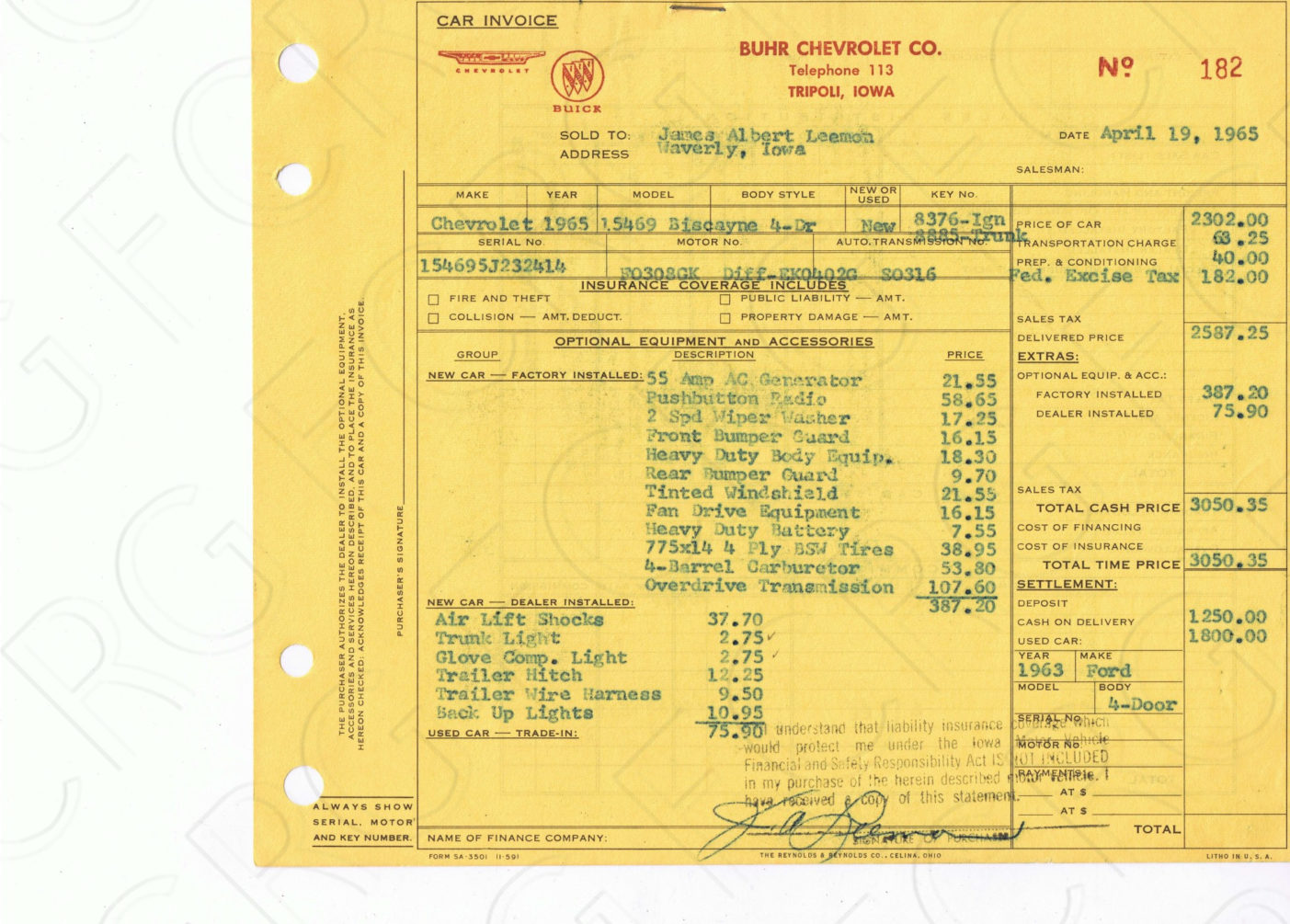

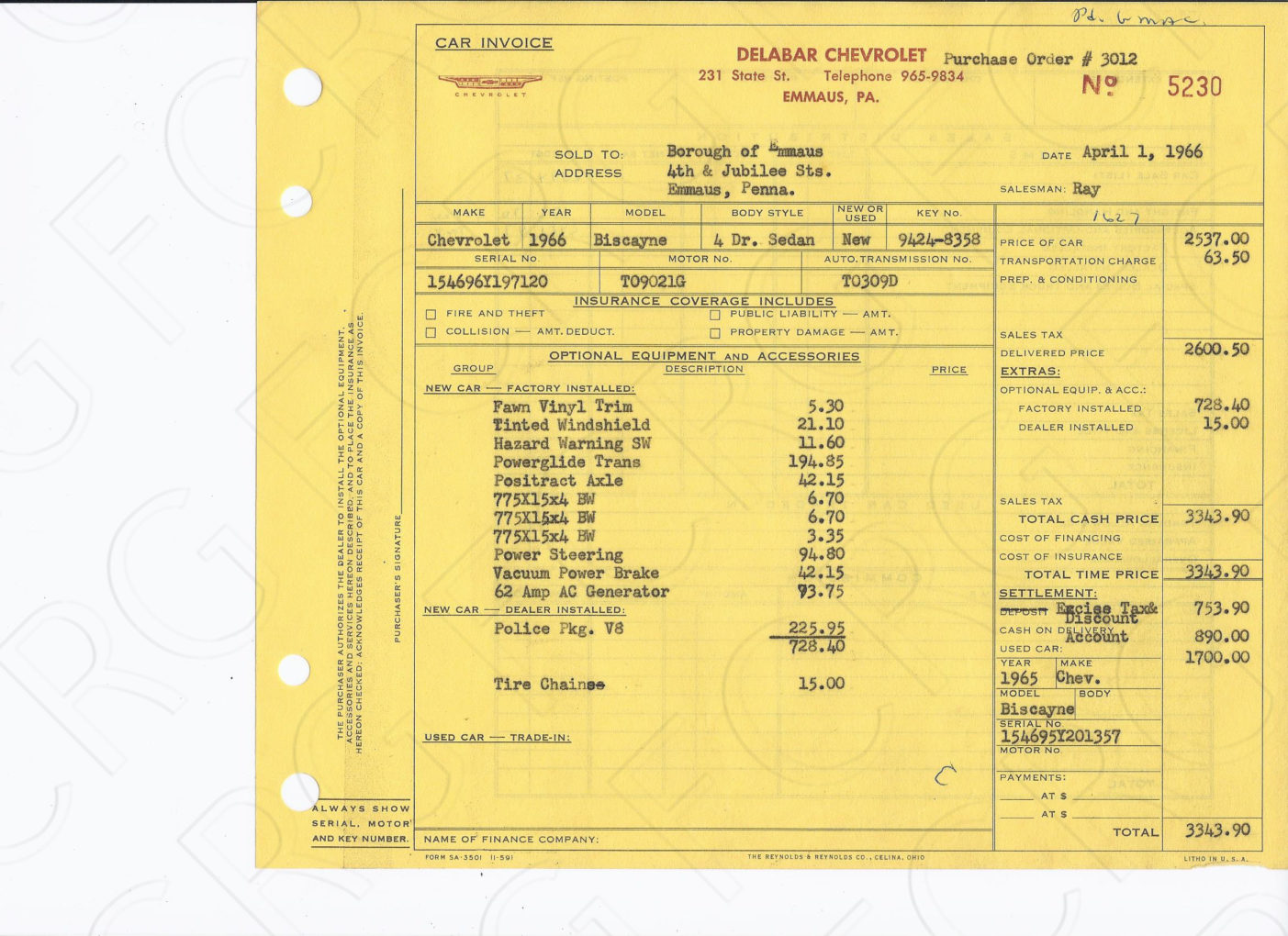
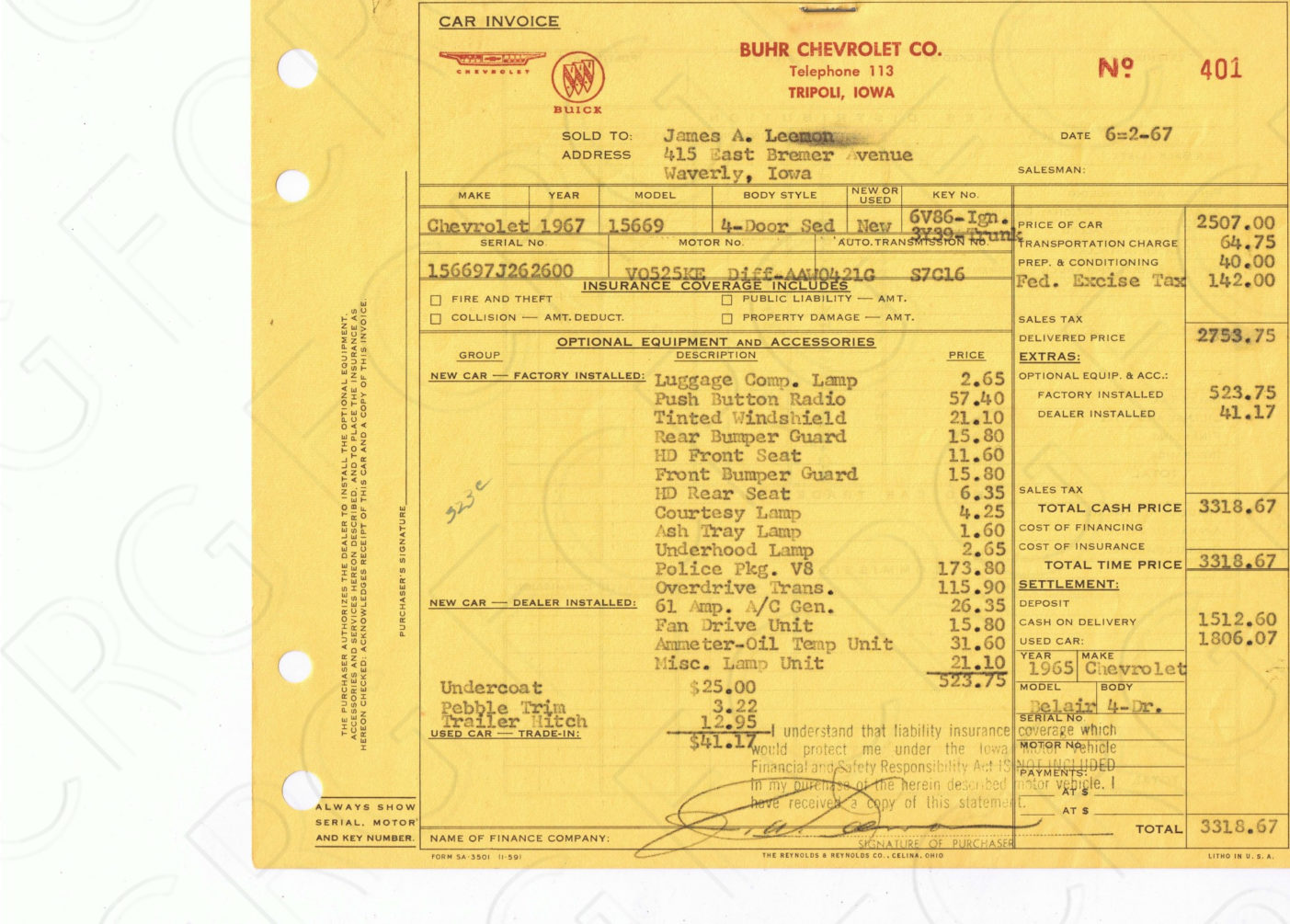
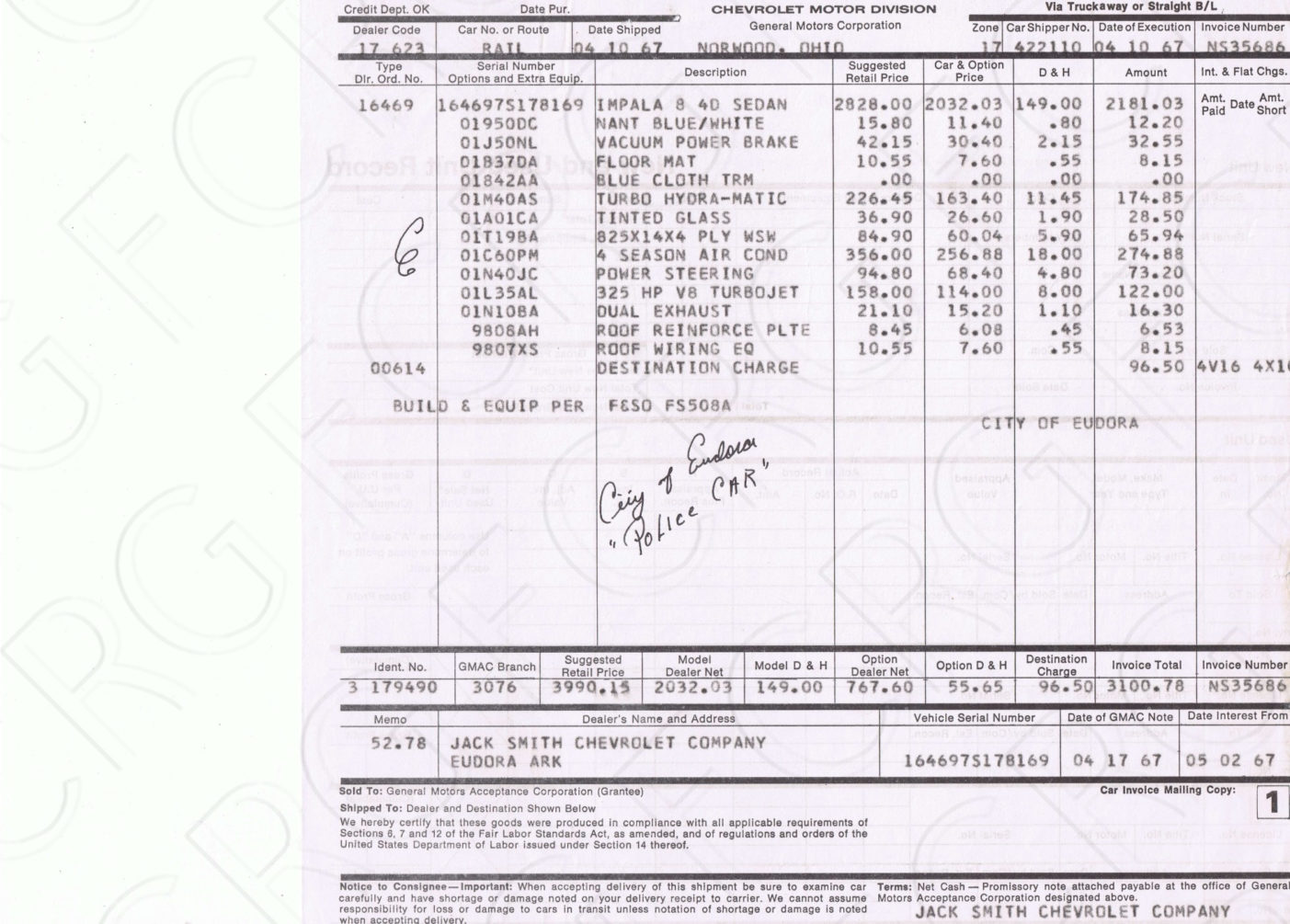
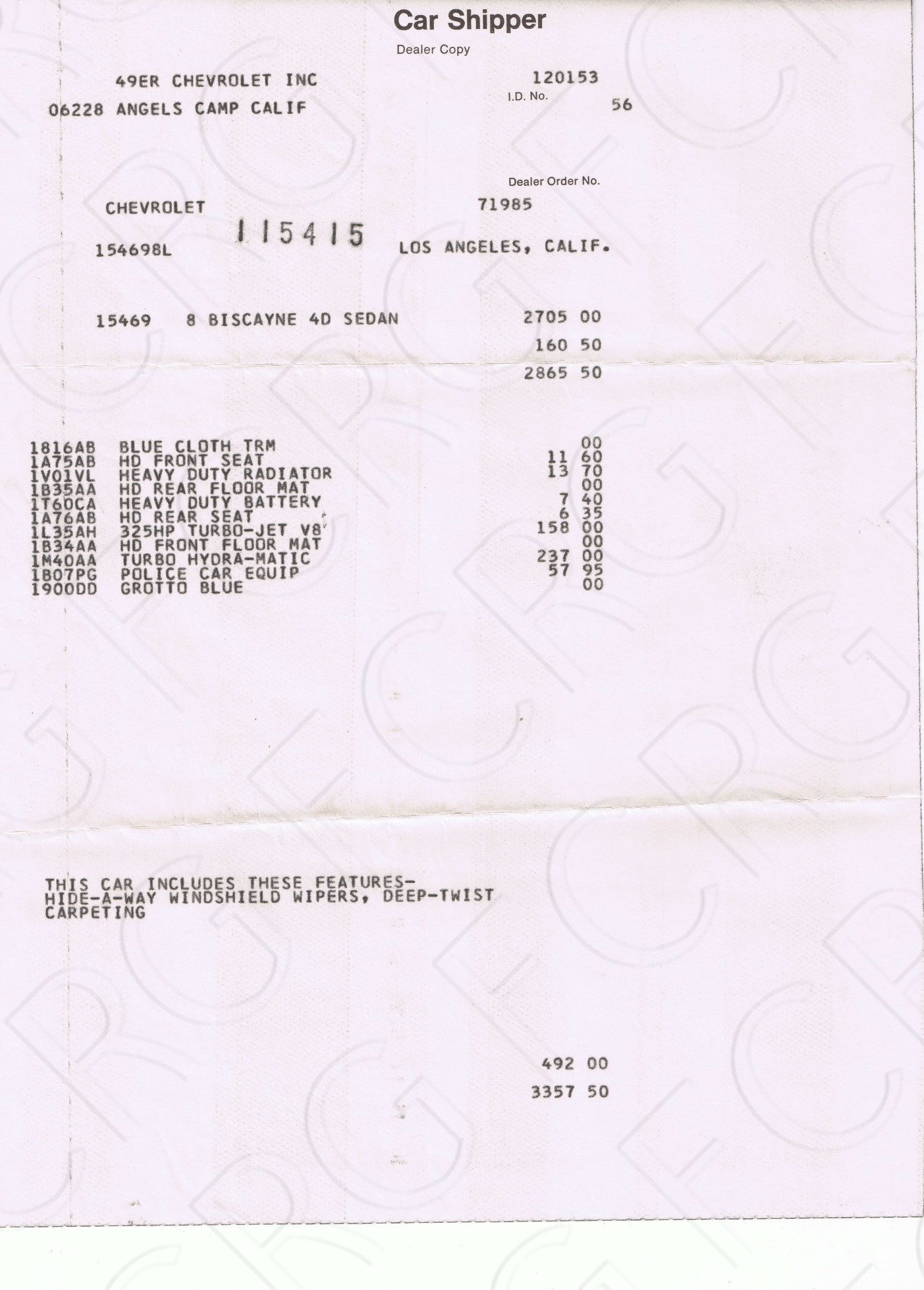

The following 6 photographs show the factory installed A-pillar reinforcement for a spotlight and roof reinforcement plate on a 1969 Biscayne police car.
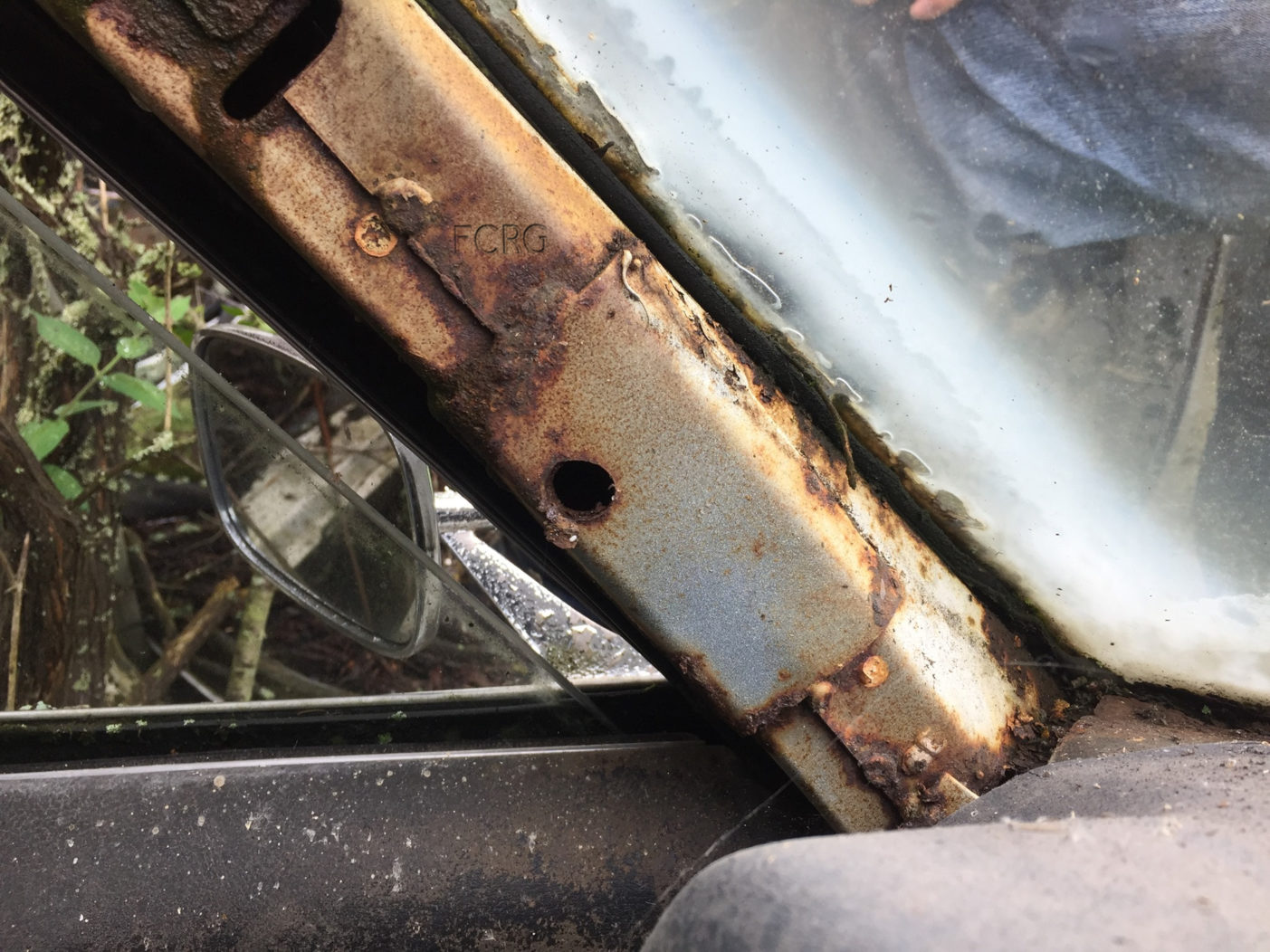
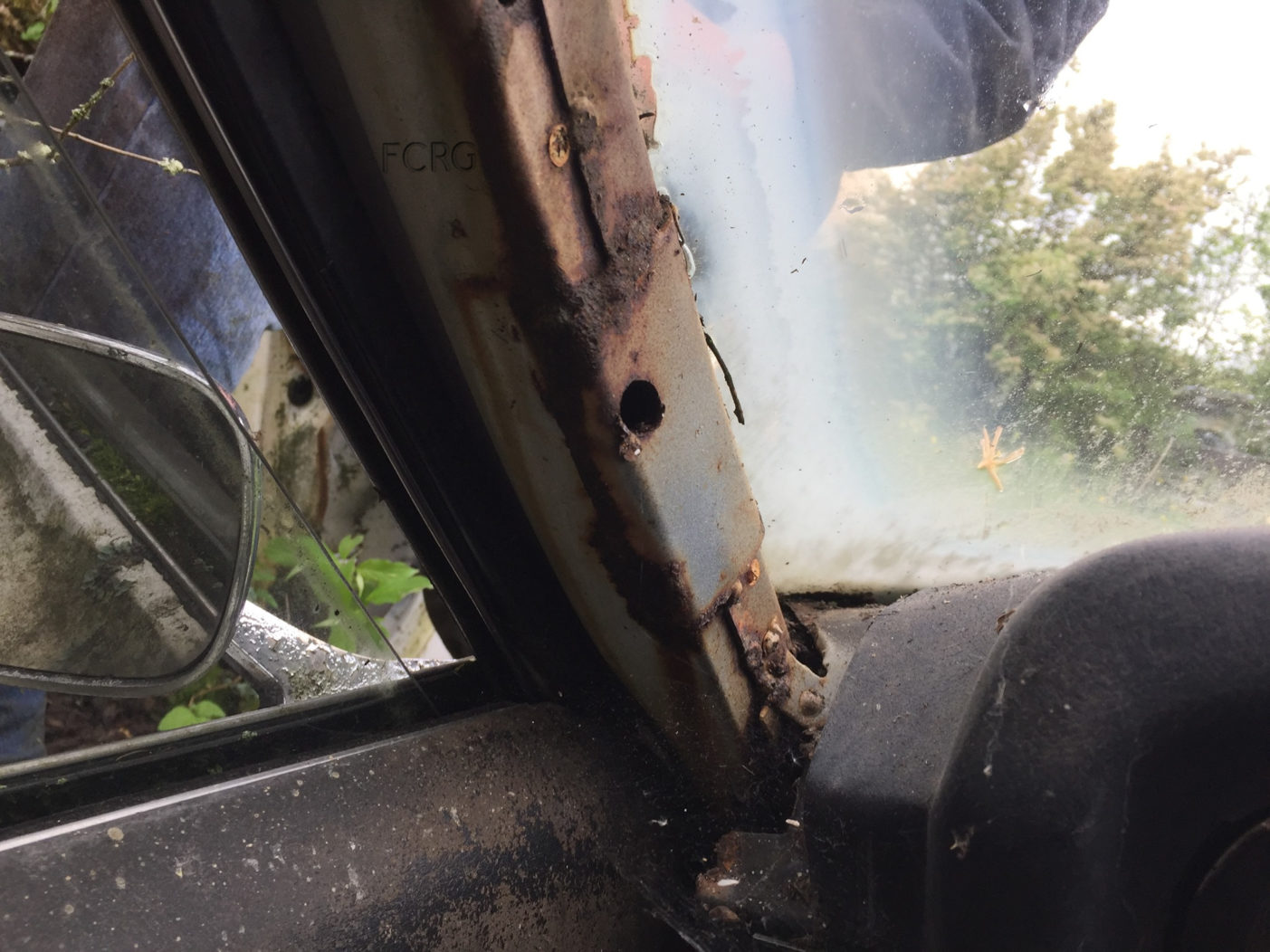
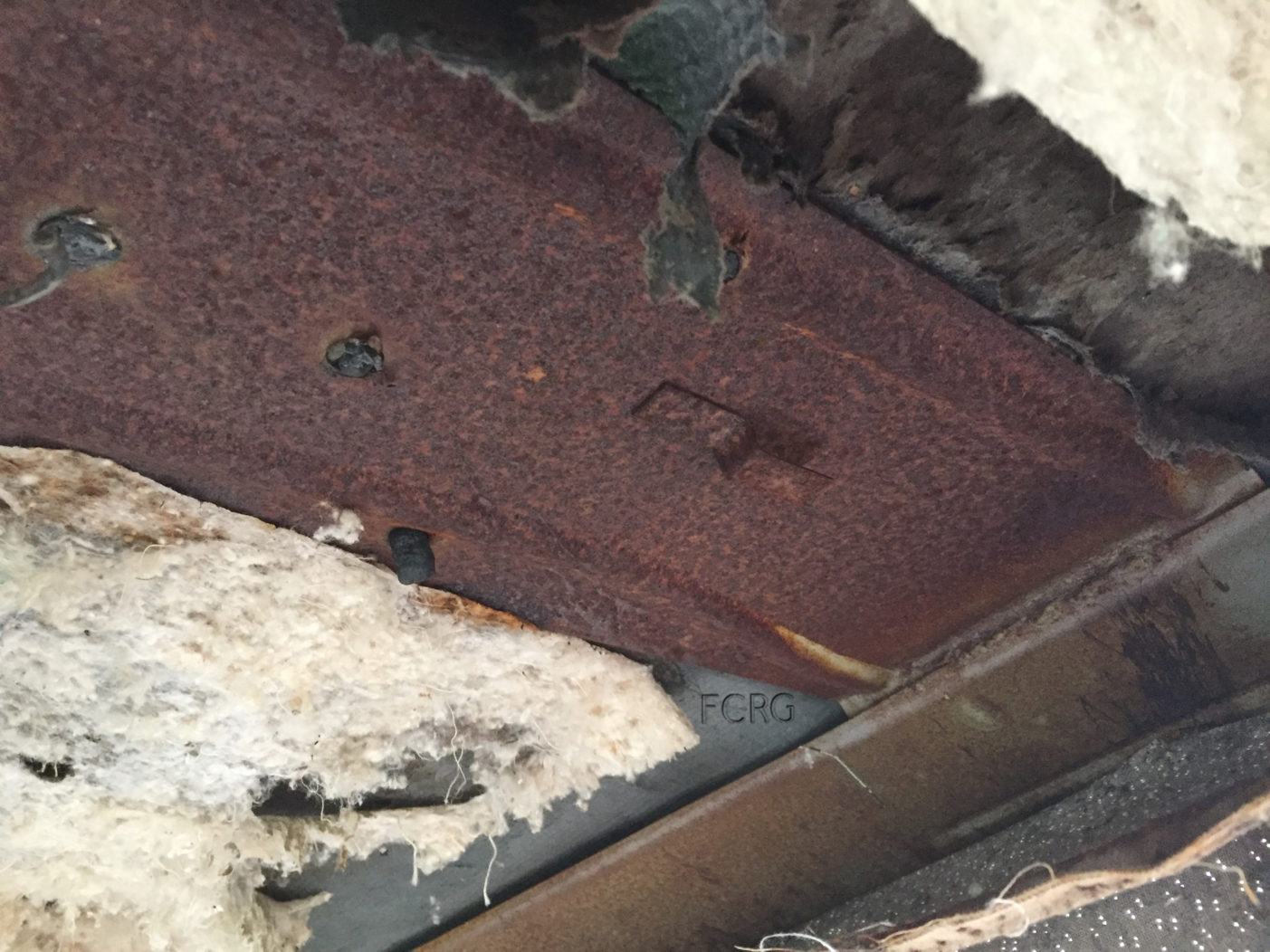
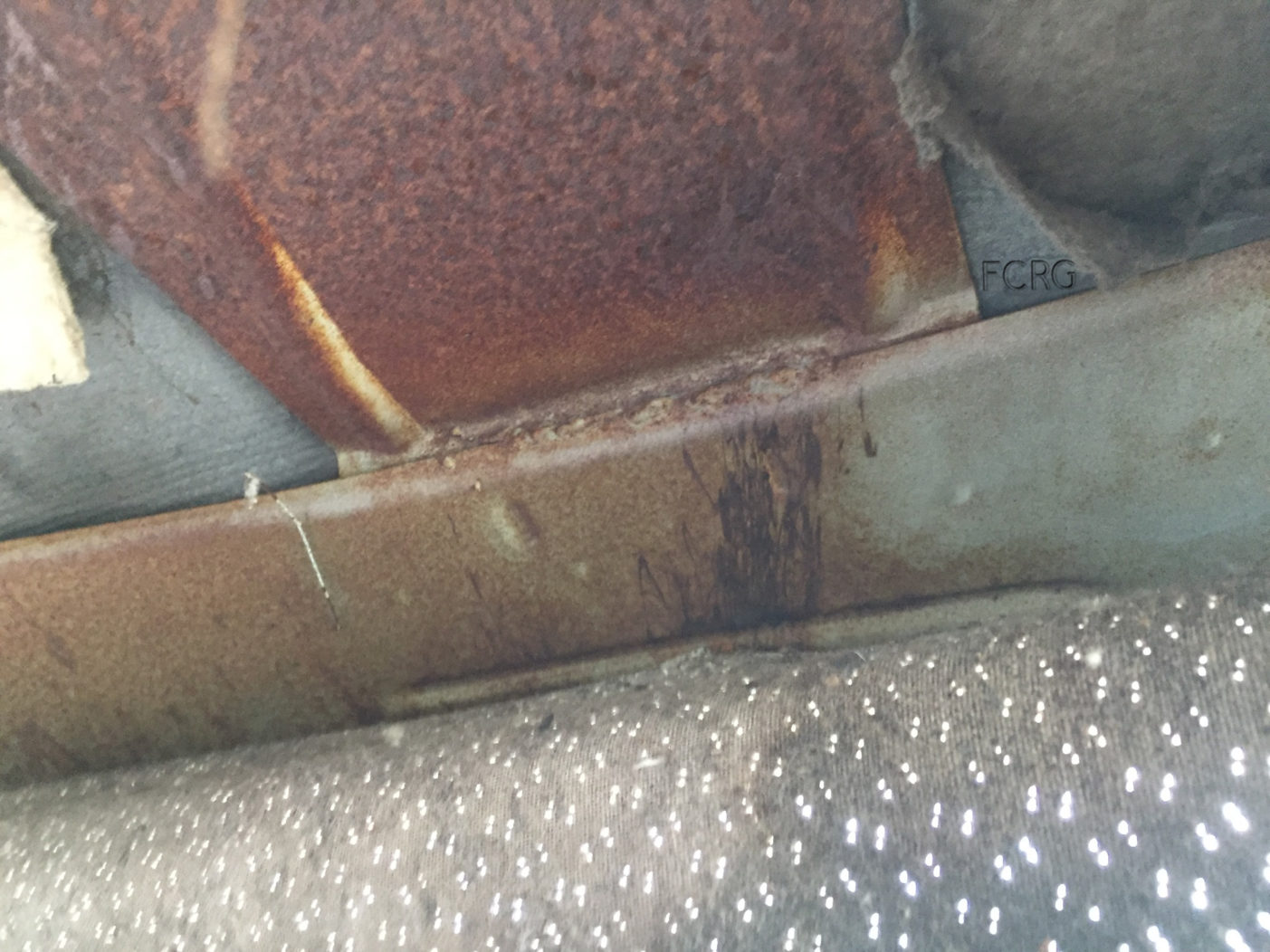
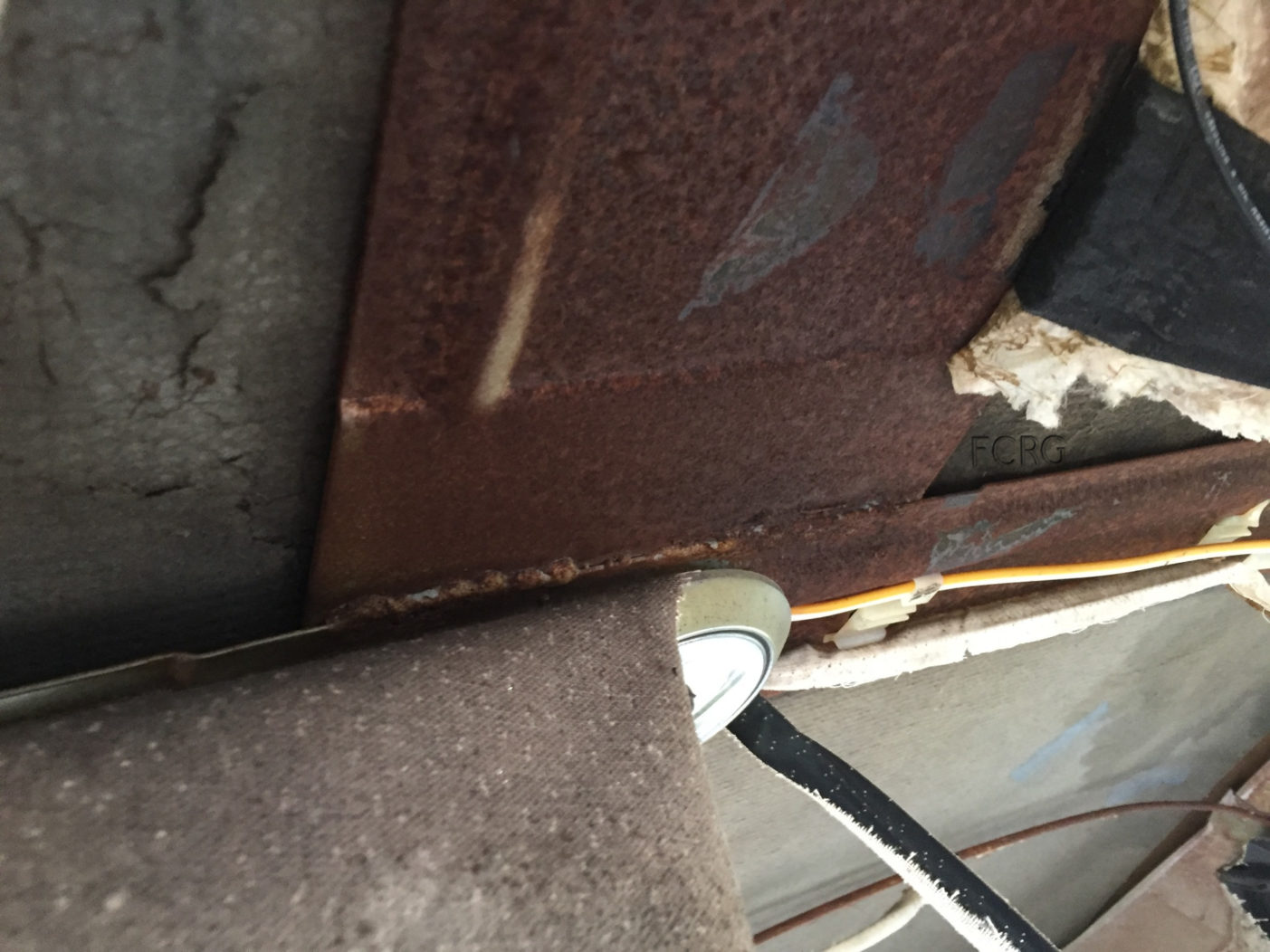
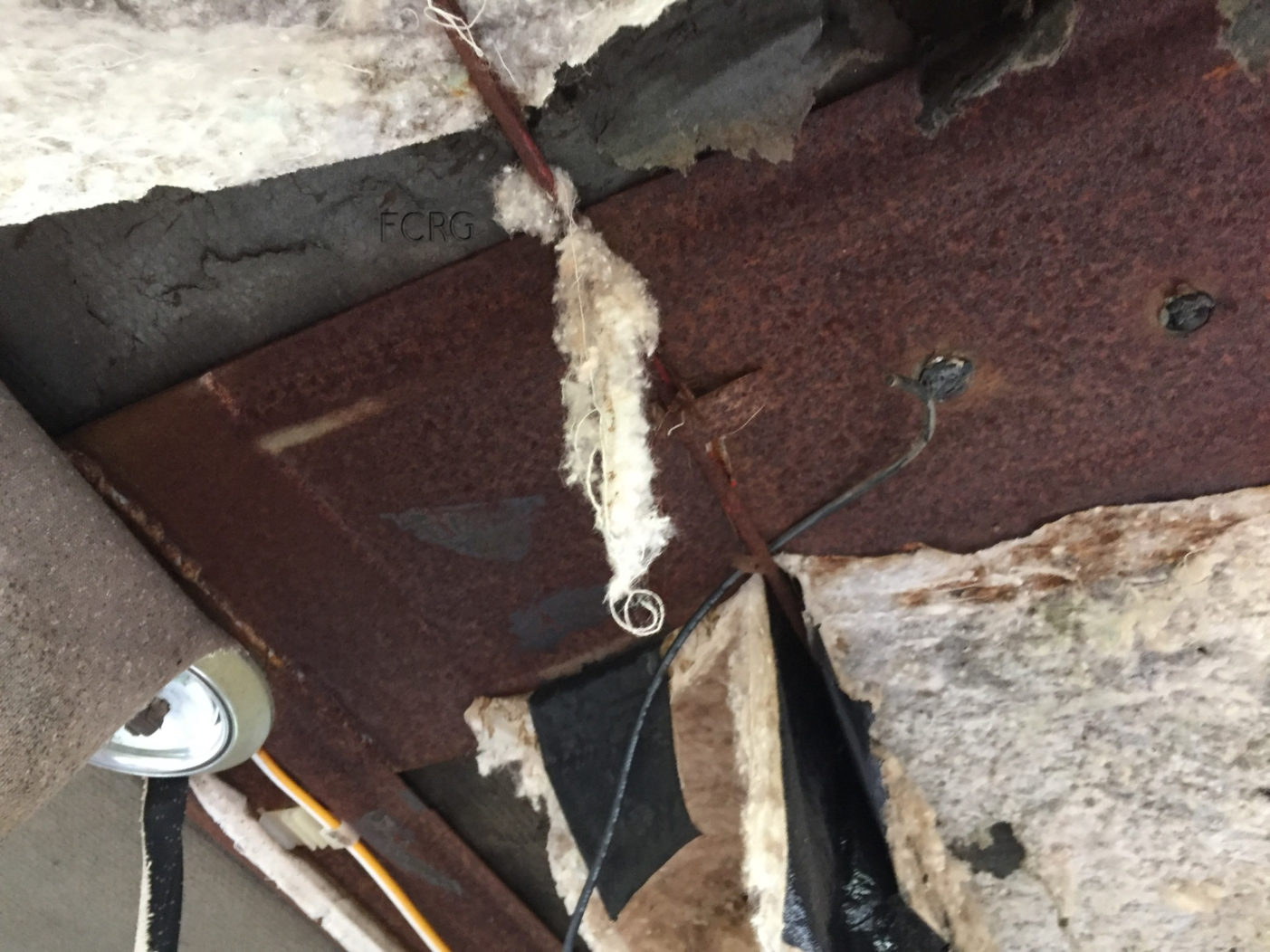
Government Vehicles
All branches of the military had Chevrolets as did the F.B.I. Based on cars we have documented in junkyards, military vehicles had special tags and decals affixed to the dashboard that were factory installed. One was a metal nomenclature plate, which was usually screwed to the glove box door. It contained information about the weight of the car and numbers related to registration and delivery. There were also some warning decals and sometimes a plastic card detailing a plant account for the branch the car was assigned to. Starting in 1966 or 1967, all government vehicles were equipped with smog equipment, regardless if they were sold in California or not. The 1967 Biscayne 396 below was ordered for the FBI and has the most COPO’s we have ever seen on one car. Whereabouts of the car are unknown.
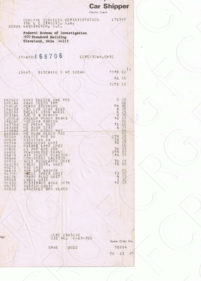
The following 6 photos are of two military vehicles we found in a junkyard years ago. Note the special paint code on the cowl tag. Also, 71A is the F&SO number. The VIN tags of these cars were stamped with the bid number, in this case C67 107. They also had several factory installed decals and tags that were special. The one missing from the glove box door had the weight and branch of military stamped into it. The decal to the right of it describes the process if the warranty needs to be used. The plastic card has the account number, which I believe would have been used for billing of certain work.
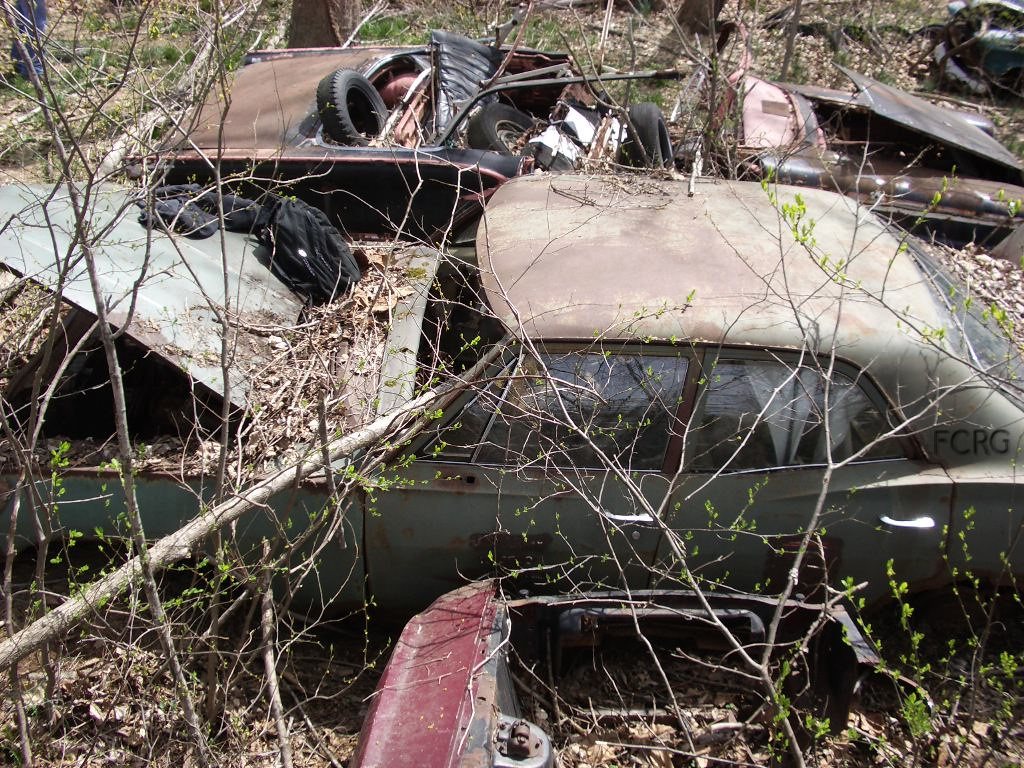
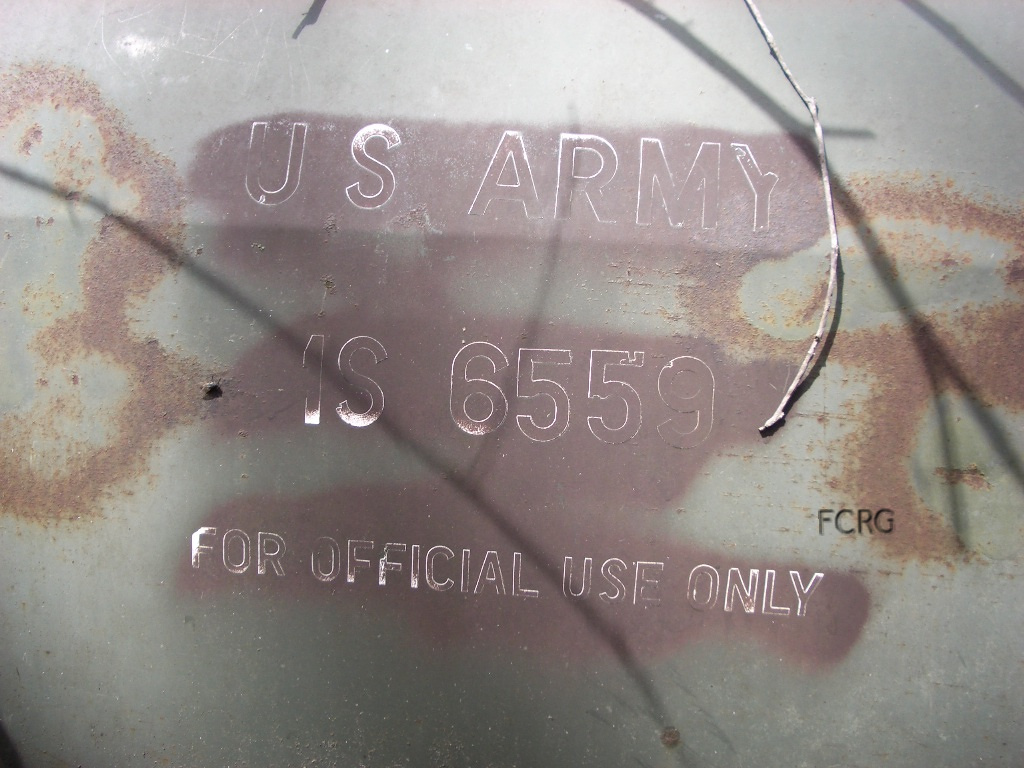
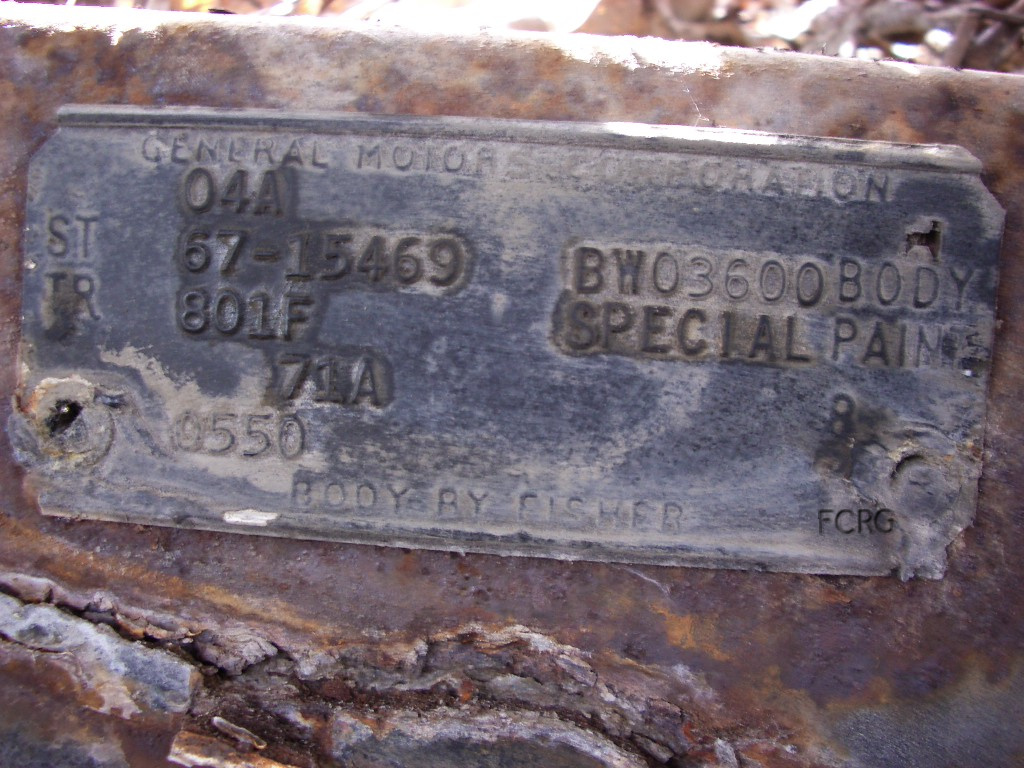
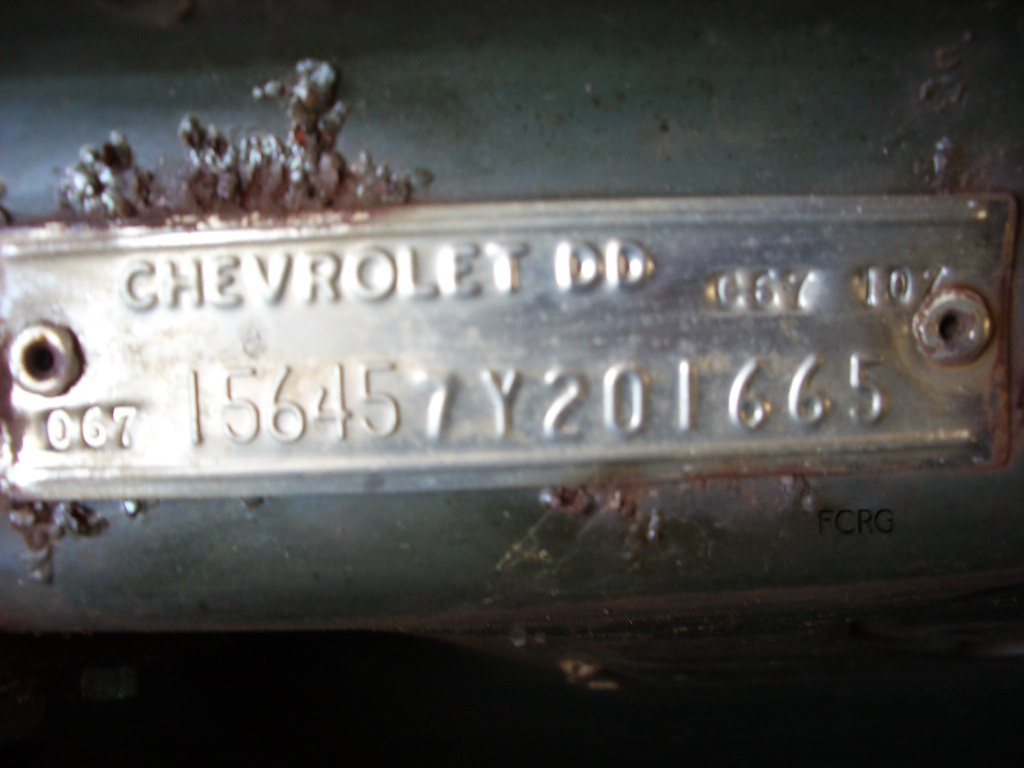

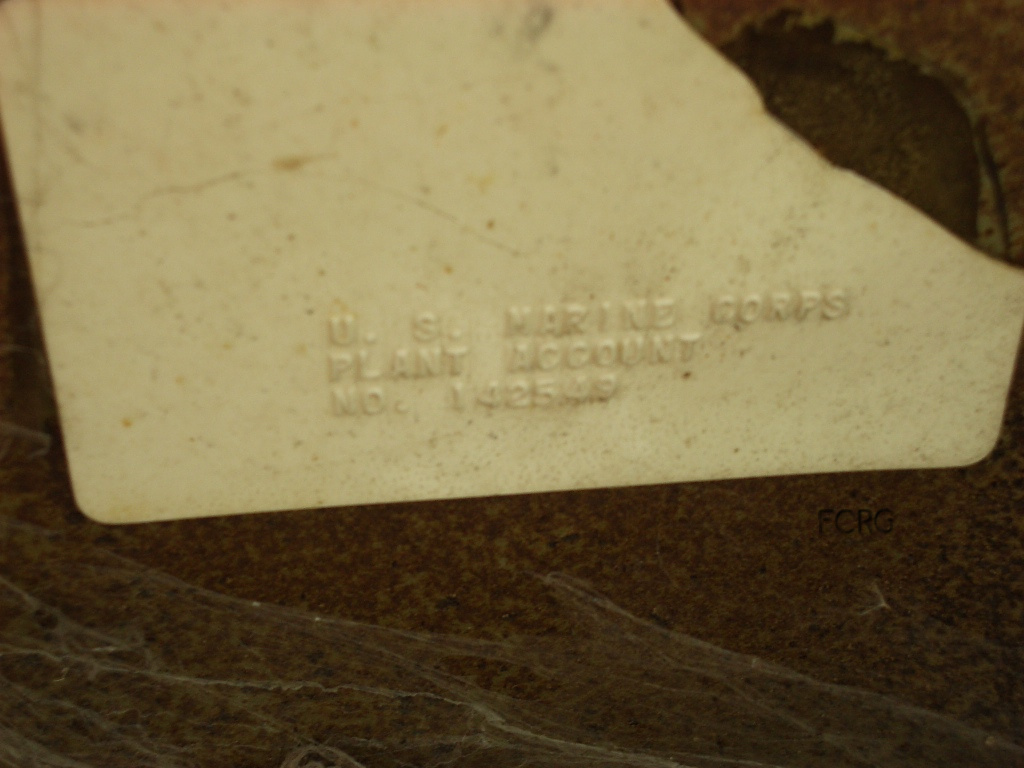
Taxicabs
There were many Biscayne taxicabs built in the 60’s. The official option was B02 Taxicab Equipment. It included heavy duty shock absorbers and front & rear springs plus 7.75×15” tires. When ordering the package with a Powerglide transmission and 6 cylinder engine, the heavy duty radiator was included. Most of these cars were ordered with special paint and the 865 fleet-type vinyl interior. There were COPO options available with these cars as well. To get air conditioning on a taxi, you had to order COPO 9801. Limited information is known about this option. Z05 Economy Carburetor was available on 6 cylinder Biscaynes in 64 and 65. In an interesting story, the owner of the Dayton Yellow Cab Company in Ohio was not satisfied with the performance of the carbs and requested for something more improved. In 68, he got his wish when Chevrolet made a special Rochester carburetor available as a replacement for option Z05. It was known as COPO 9608. See the letter below. Also included is the original purchase order and invoice from one of the taxicabs from that group. Notice the carburetor is not listed on the invoice. It’s possible Chevrolet or the dealer covered the cost.

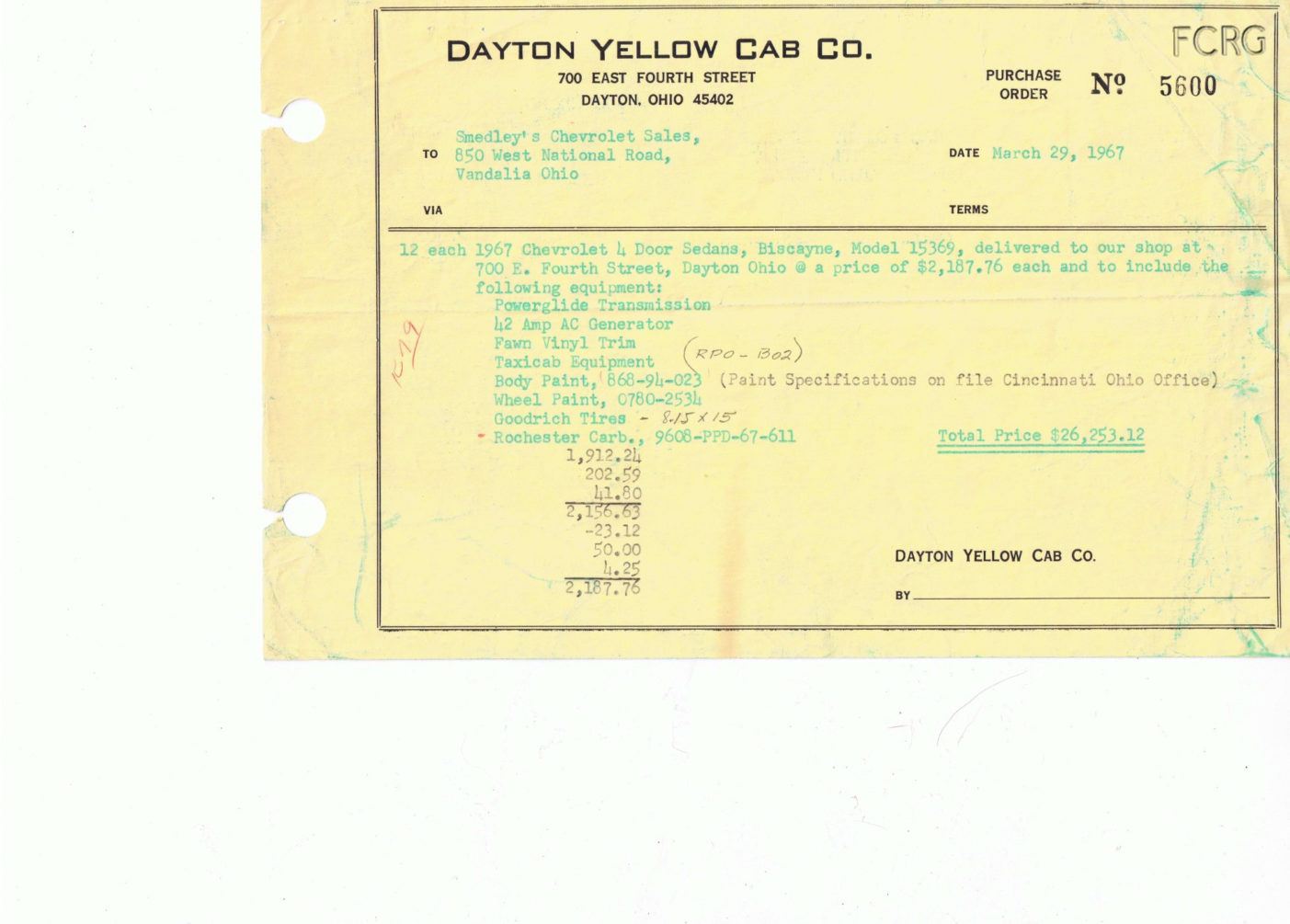
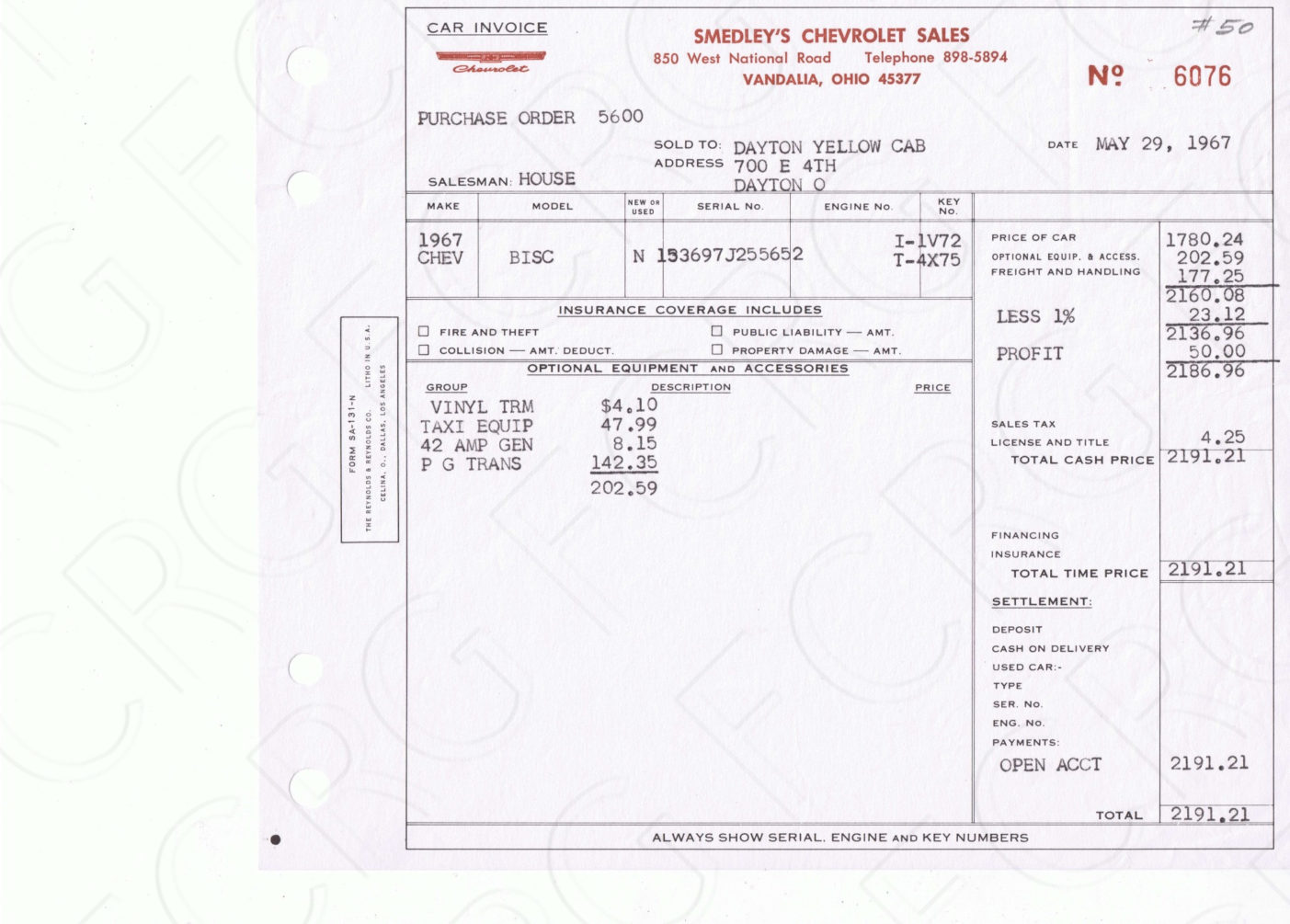
Additional Taxi photos:
First row: 1960 dealer invoice, postcard from Jerome-Bebe Cab Co, Bronx NY showing off new 1969 taxicabs with disc brakes to prospective drivers, and letter on cooling fix for 1968 taxicabs with COPO air conditioning
Second row: 1962 taxi purchase order, factory invoice and dealer invoice. Note on the factory invoice 30001 is special paint and 330A is taxicab equipment.
Third row: Bids from 2 different Dayton, Ohio Chevy dealers for 1968 Biscayne taxicabs and a frame deviation drawing for the assembly manual: 1965 taxicabs with COPO 9804 (most likely air conditioning)
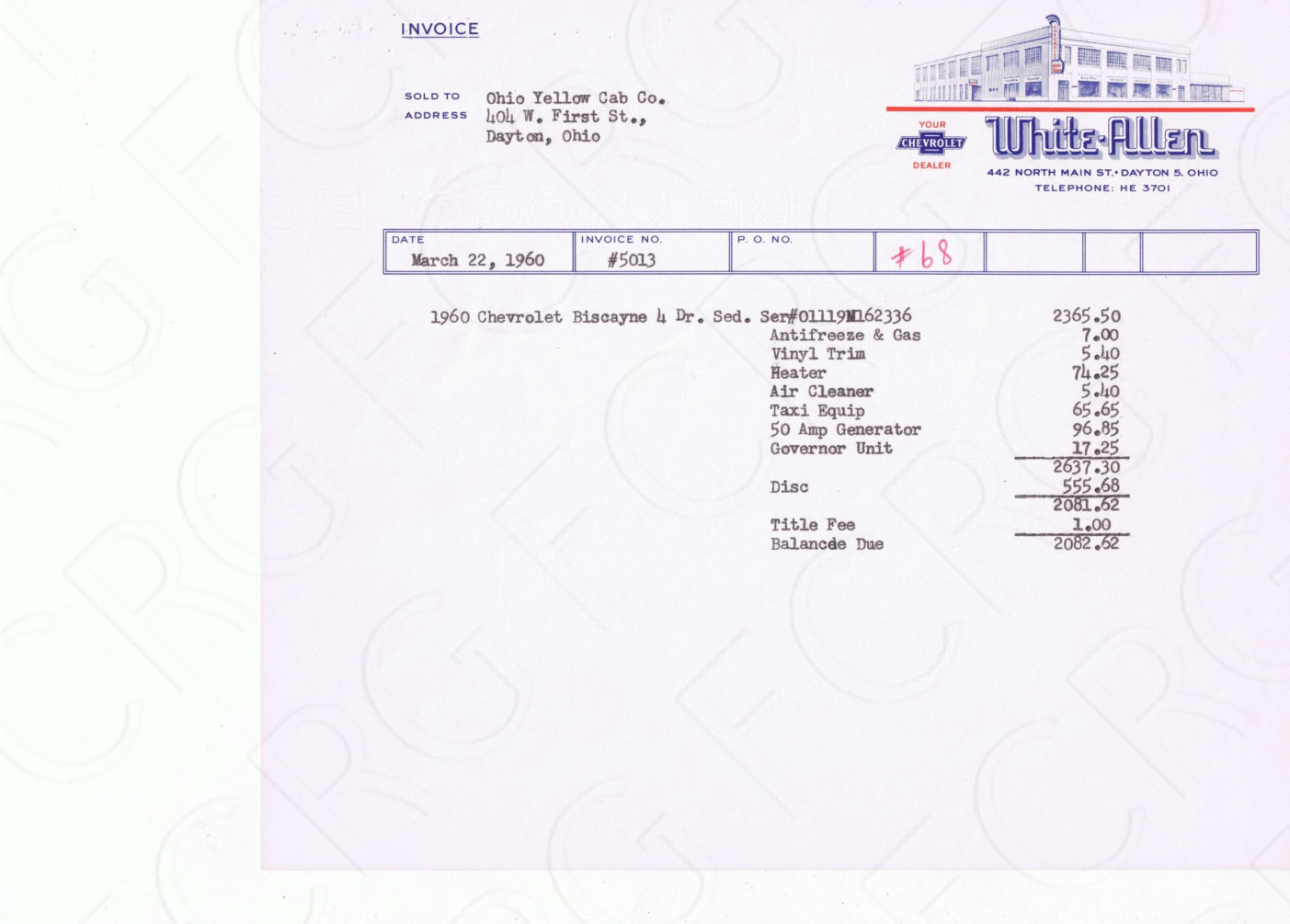


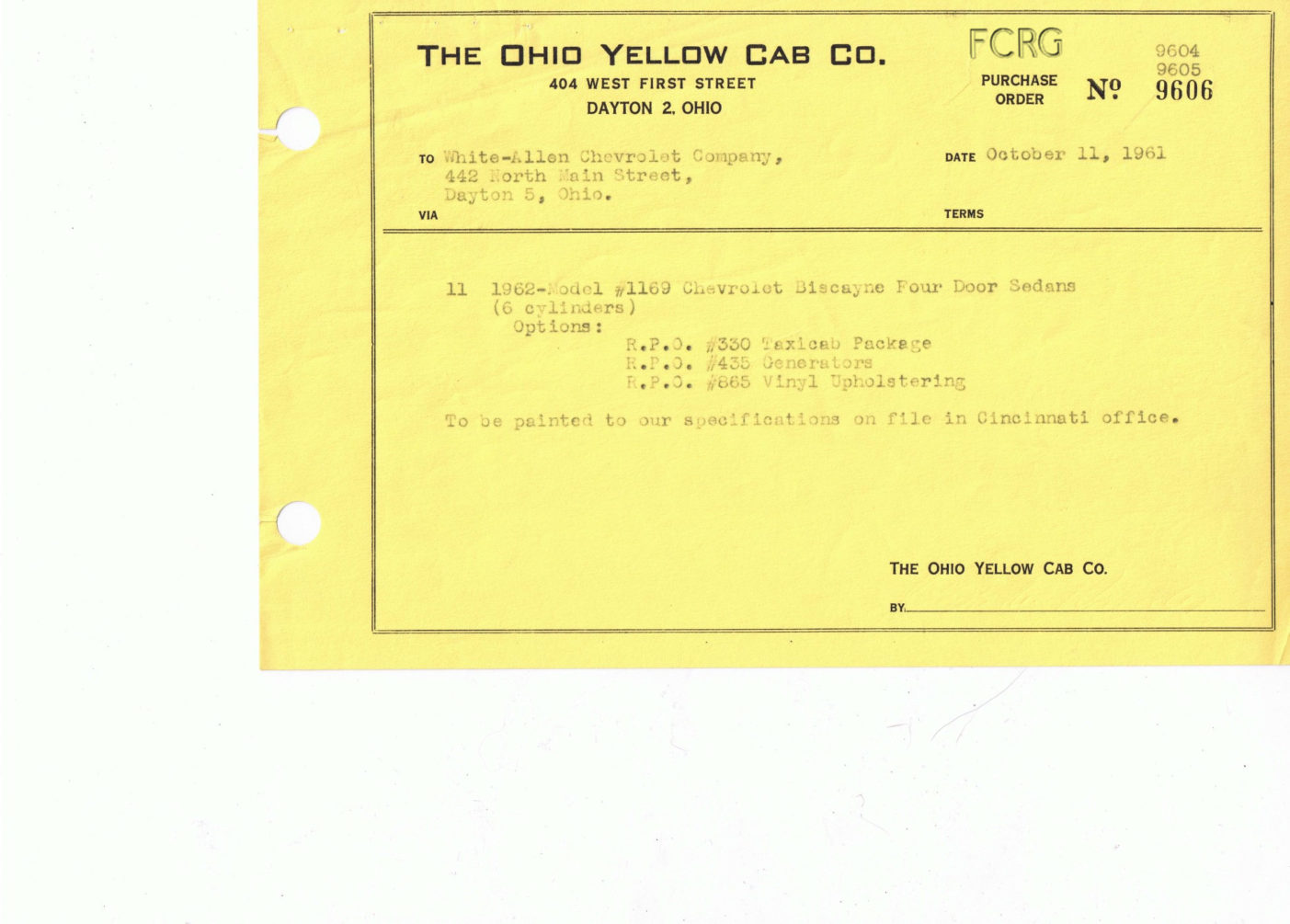

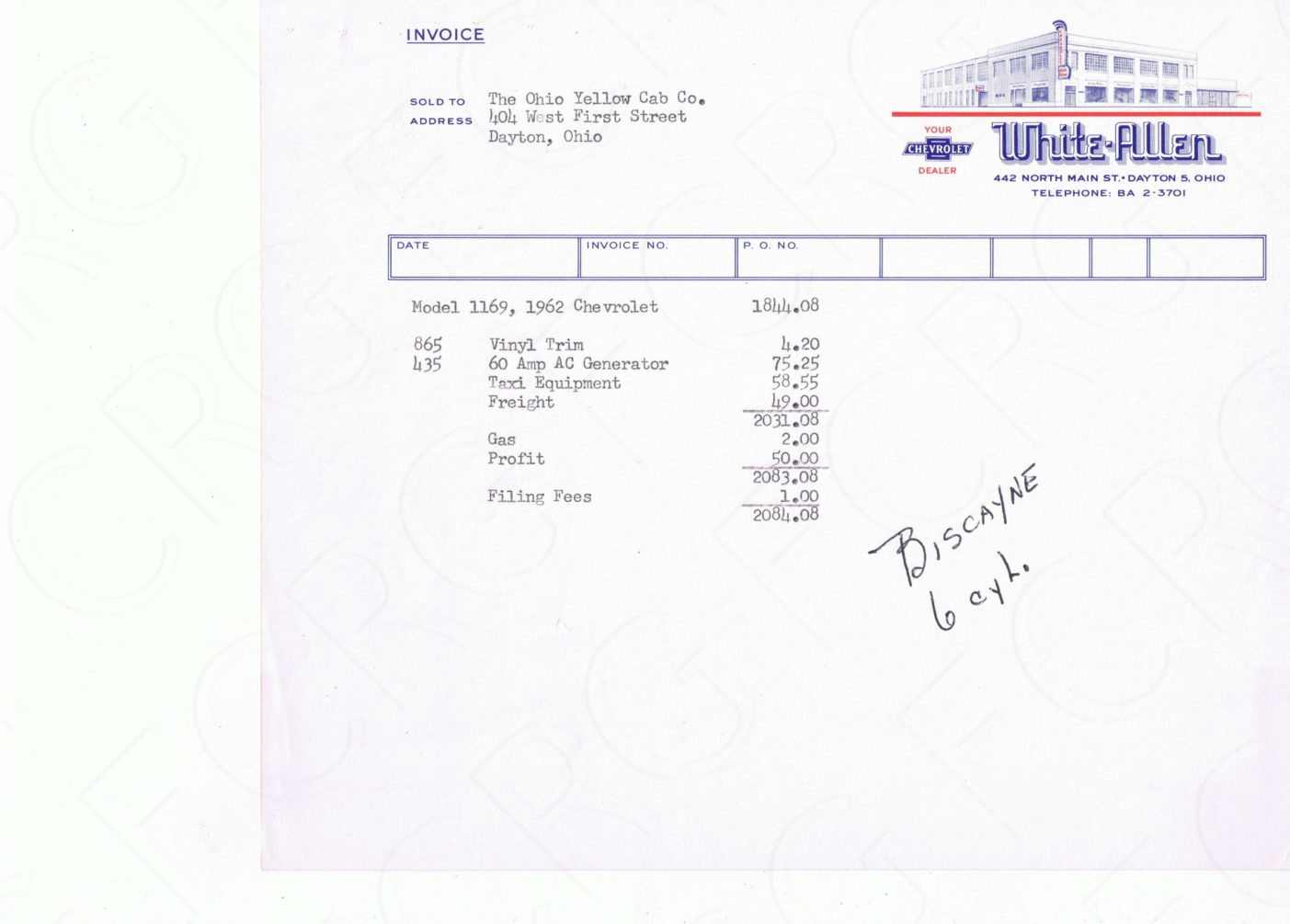
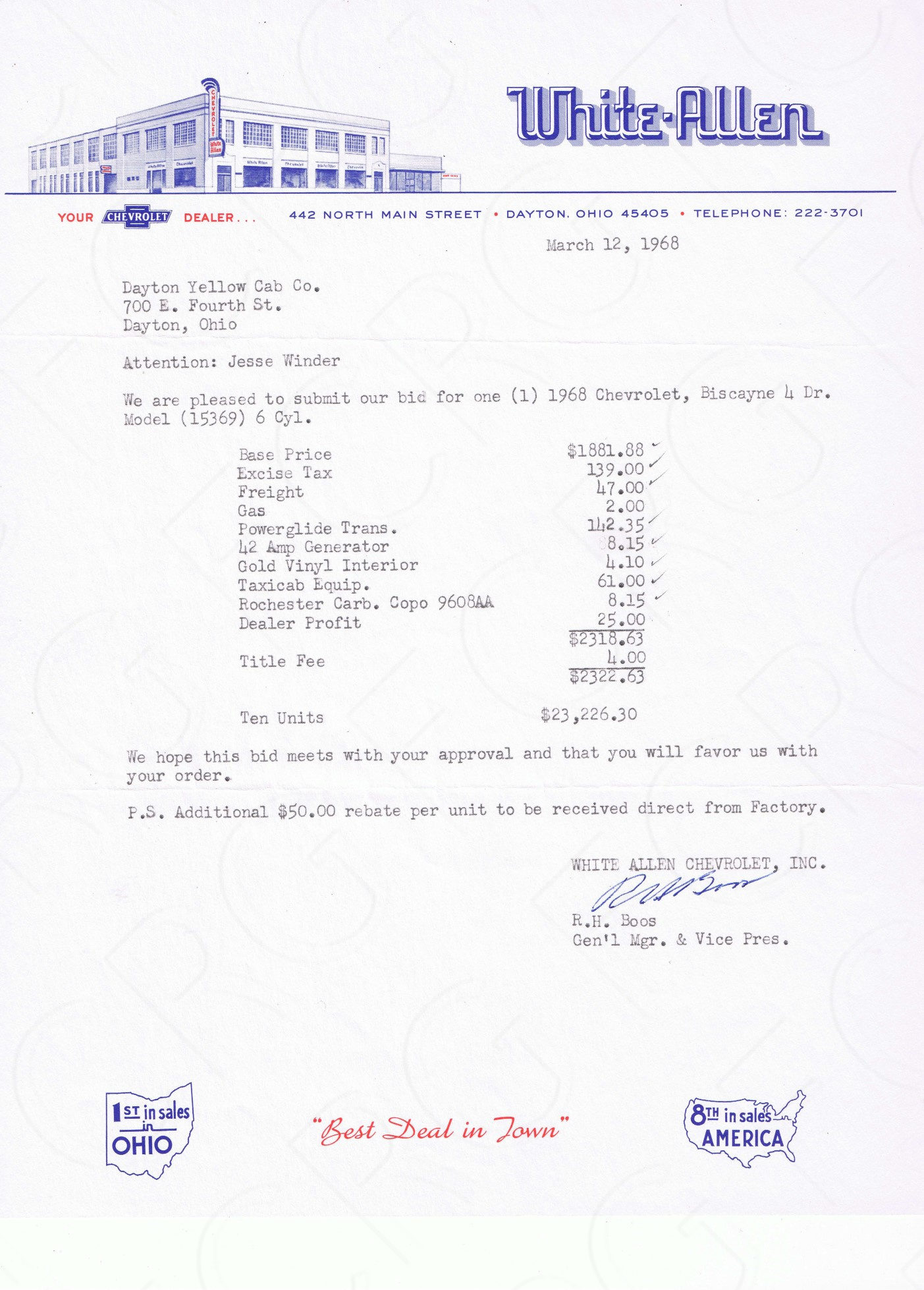
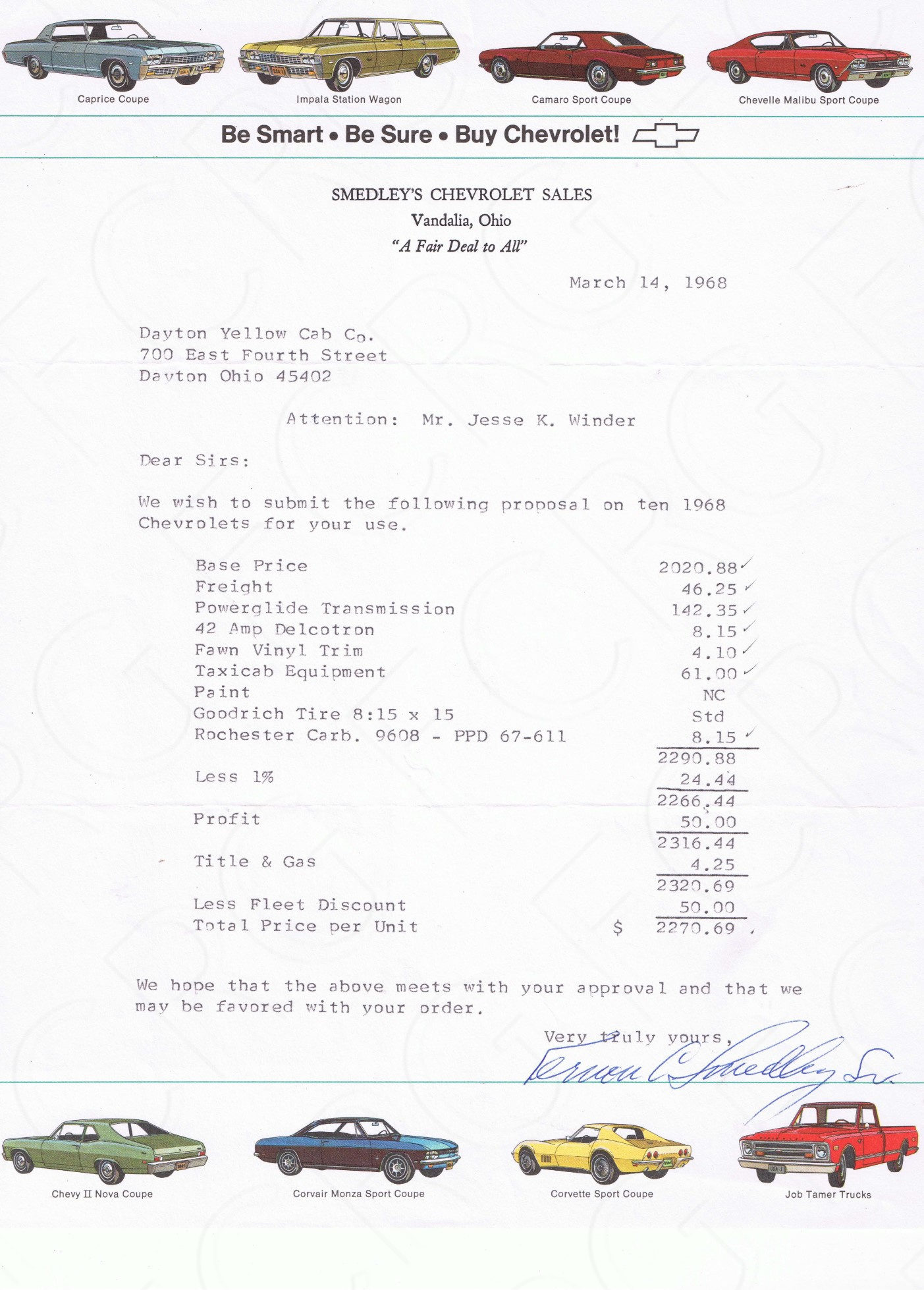
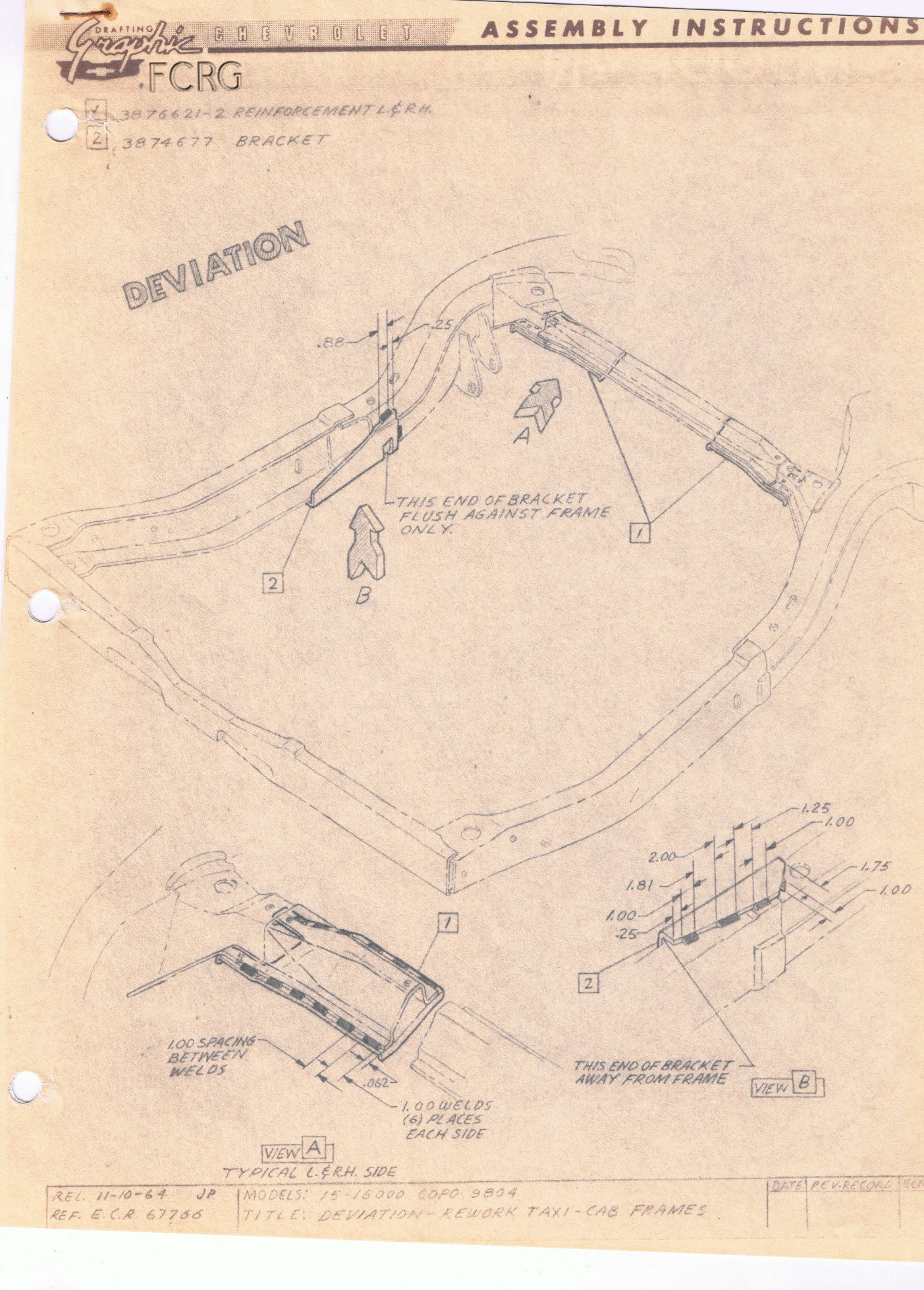
Specific COPO Options
COPO 9665 – Turbo Hydramatic 350 for 1968
Most in the hobby have never heard of a Turbo Hydramatic 350 (TH350) in a 1968 vehicle. It’s widely known that the Turbo 350 transmission debuted for the 1969 model year but a test fleet of 1968’s were built with it as a COPO option. More information on this option has been slowly trickling in over the years. Known as COPO 9665, the cars with this option were all driven within the company, some by executives, then offered for sale through dealerships to the public as used company cars. Production of the transmissions, which were not serviceable at the time, began in April. On the limited data we have on these cars, production began in May and approximately 2000 were built. The transmission ID code used a 9 instead of an 8 for the model year but otherwise followed the same format as 1969. The 327 was the only engine used with this option for 1968 and special engine suffix codes were used: HR for the 327/250hp and HS for the 327/275hp. We have record of just 6 such examples in our database and only 2 are known to exist. A Flint-built Caprice coupe with the option was parted out 10 years ago and the documents from a convertible (whereabouts unknown) built for the then plant manager of Janesville are in our collection. Janesville cowl tags will be stamped MEMO – CBC as it was also known as the C.B.C. Transmission.
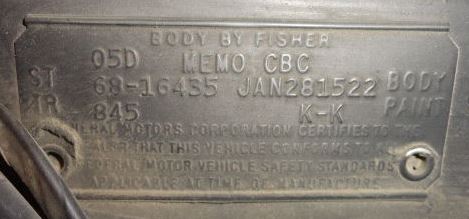
1968 Turbo 350 Gallery: Front of dealer service bulletin, cover letter for internal parts list and window sticker from Impala convertible ordered for Charlie Coffey, the plant manager of Janesville! I circled the transmission but also note concealed headlights, which was only available on the Caprice according to dealer ordering information! Note that concealed headlights is listed as an RPO, not a COPO!
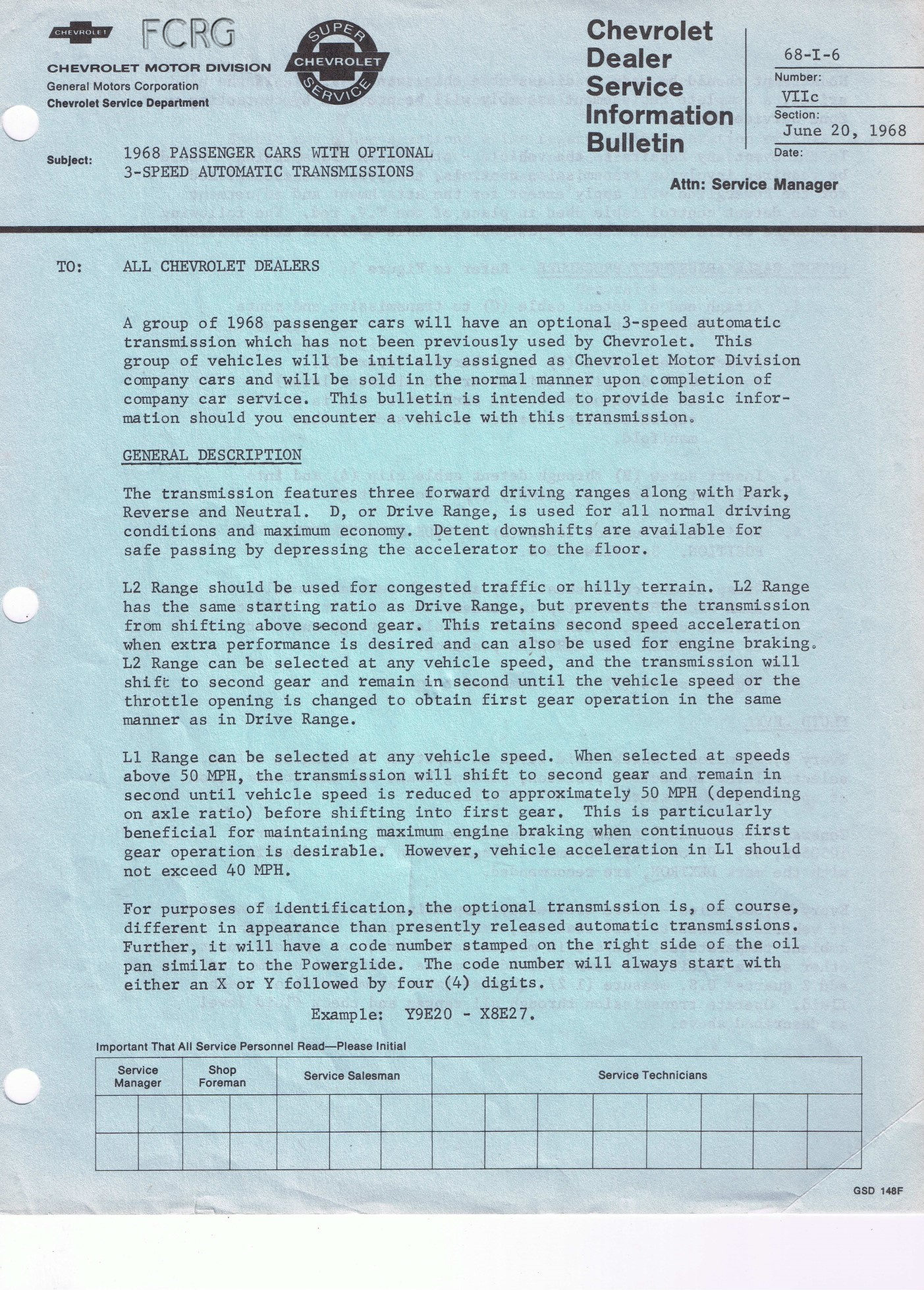
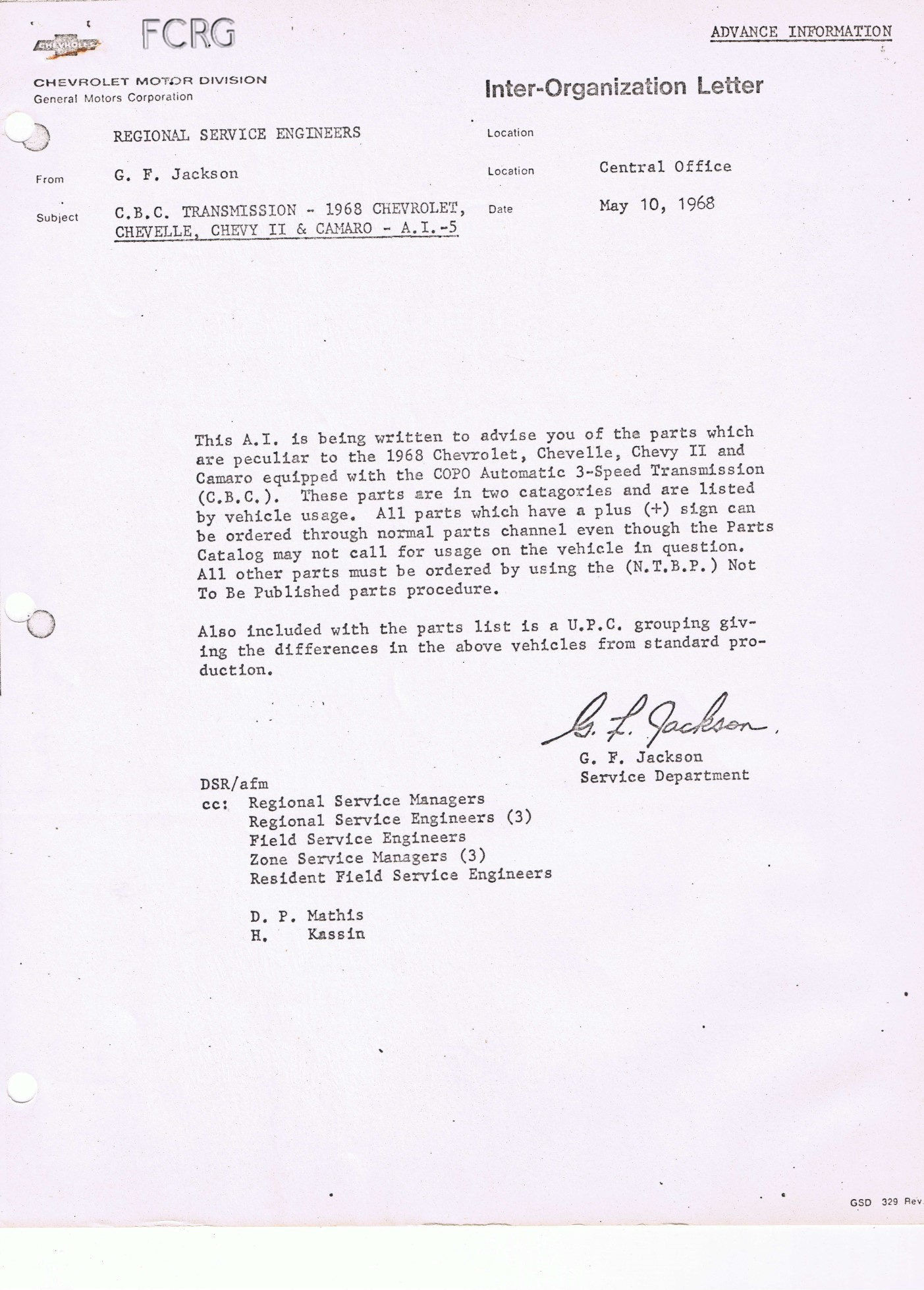
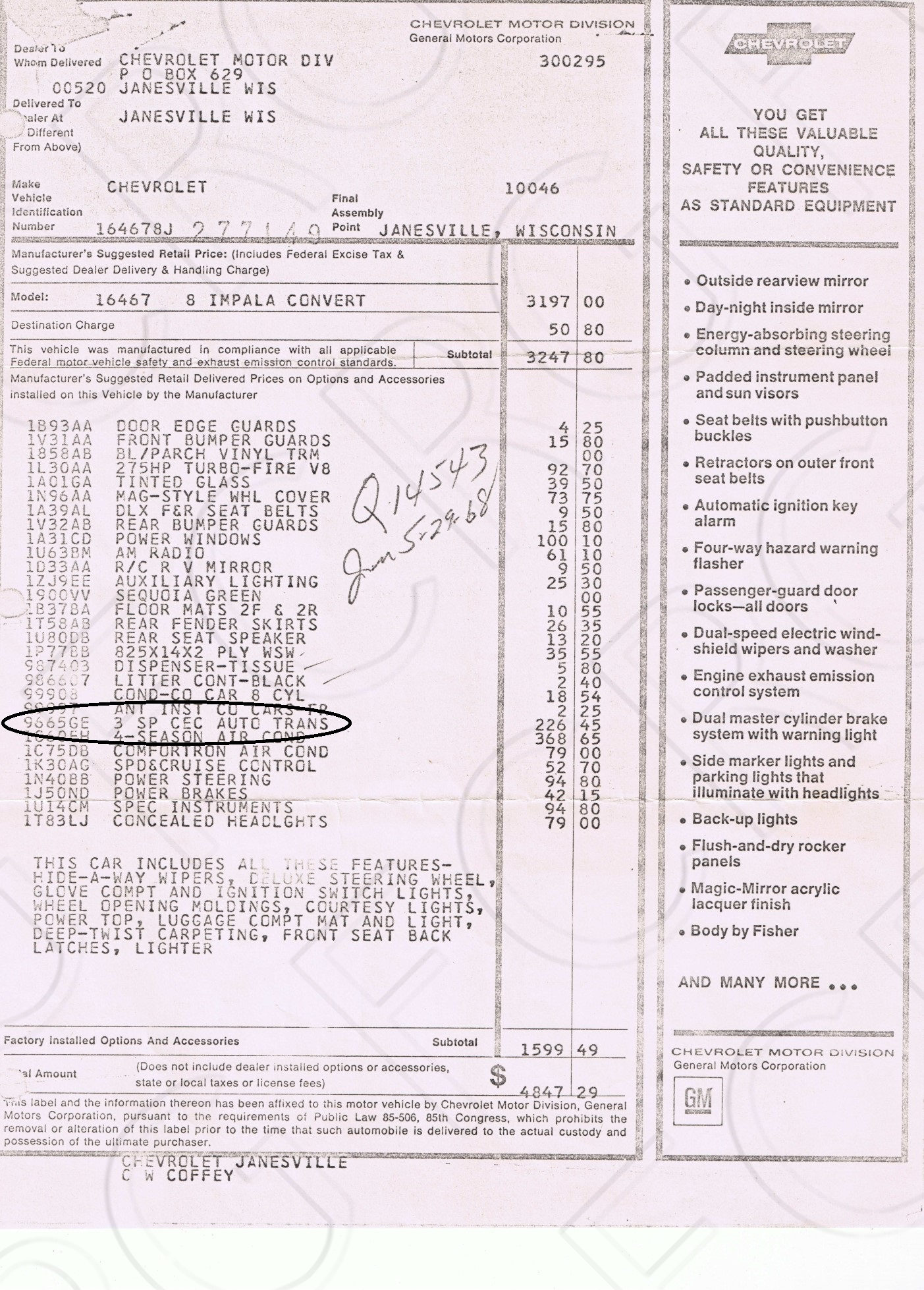
COPO 9564 – 400ci small block for 1969
Like the Turbo 350 transmission, the 400ci small block was used in a test fleet in 1969, the year before it officially debuted. Known as COPO 9564, it was paired with the Turbo 350 transmission and all cars with the option were Lordstown-built. Engine assembly, with 1970-style suffix code, CGR, began in late May at Tonawanda while car assembly started in early June. With just 9 records in our database of the option, only 2 cars are known to exist at this time and one of them is in a junkyard. Notice the one pictured in the junkyard has 350 fender emblems! Also pictured is a zone to dealer invoice of a company car with that option. (circled)

